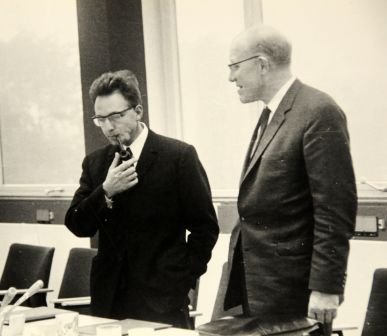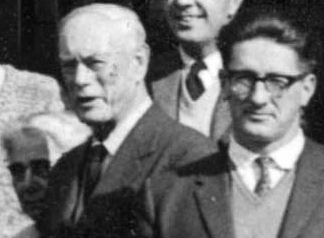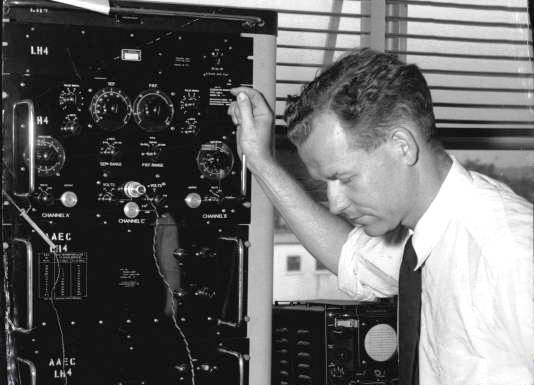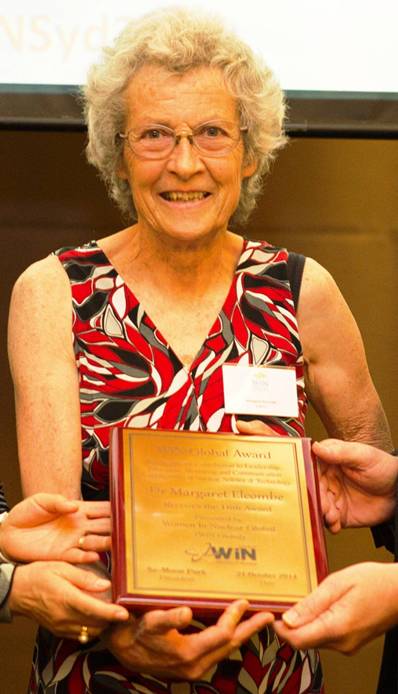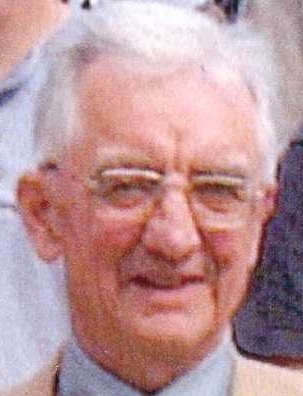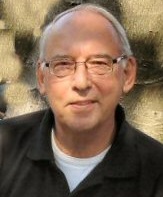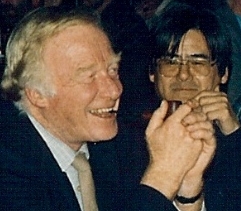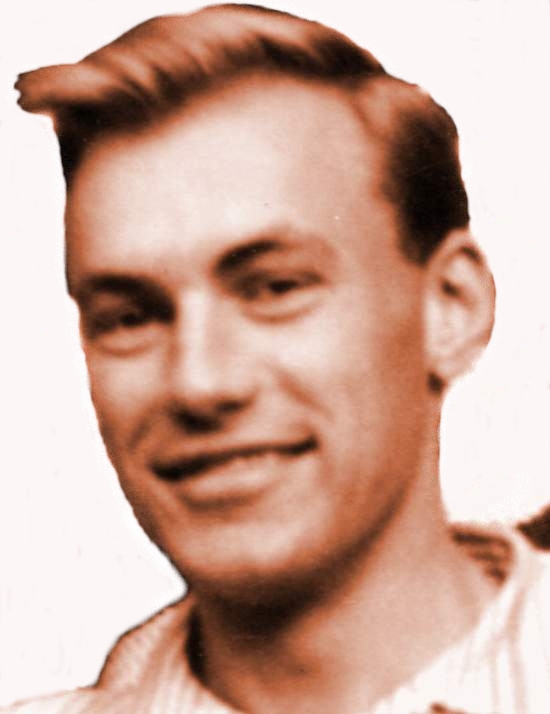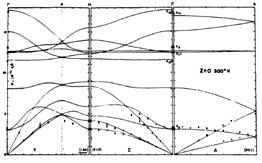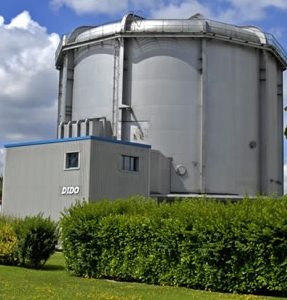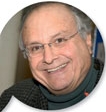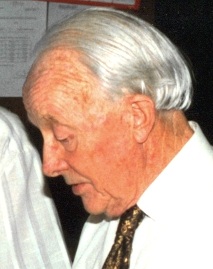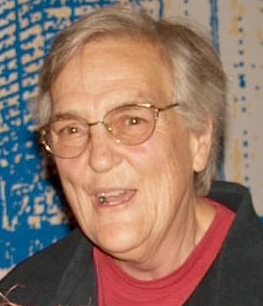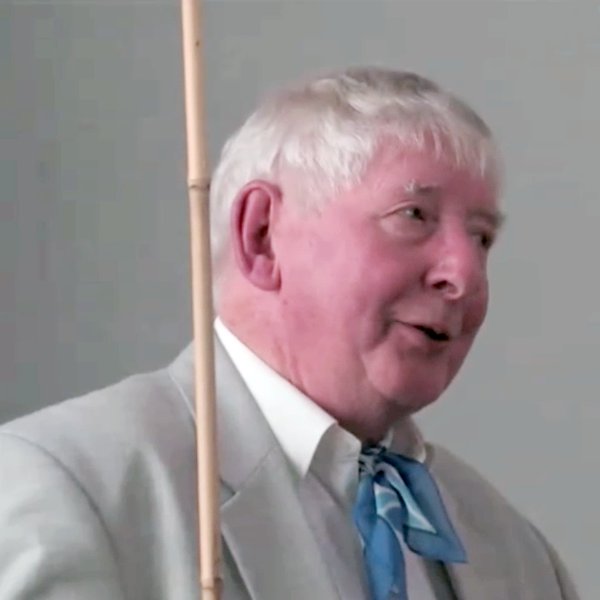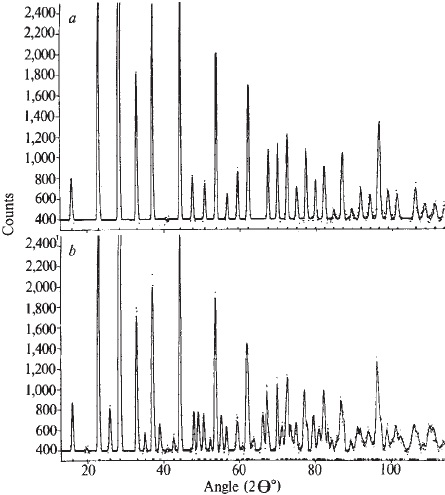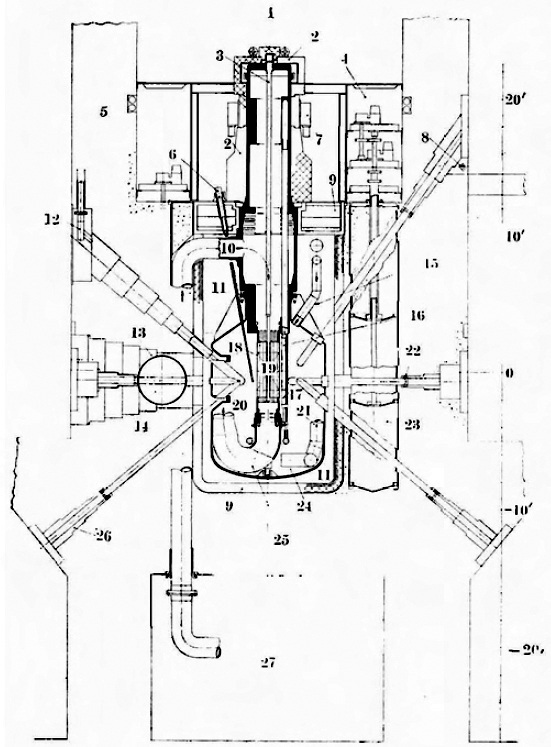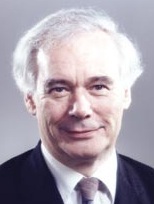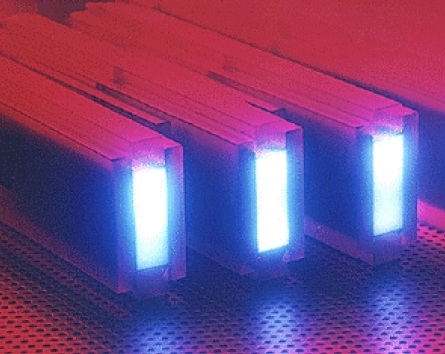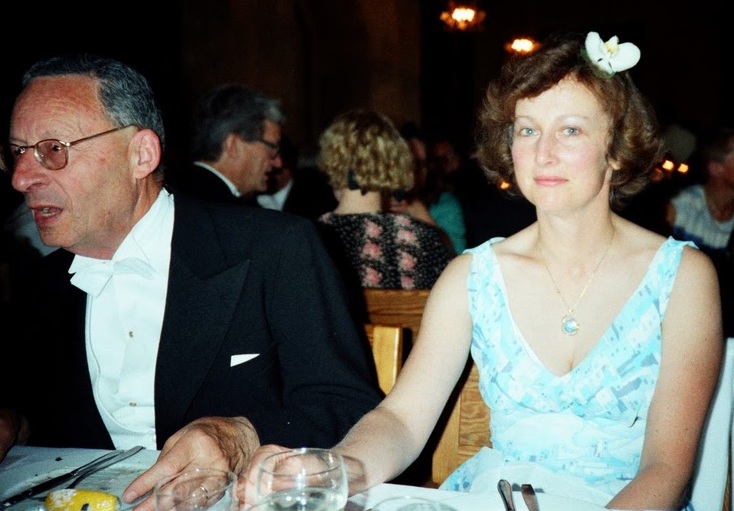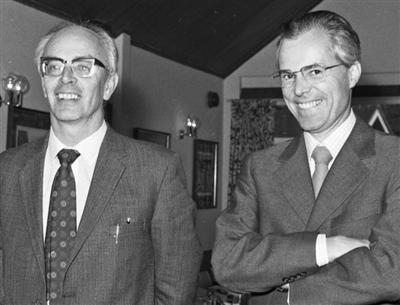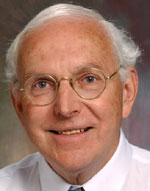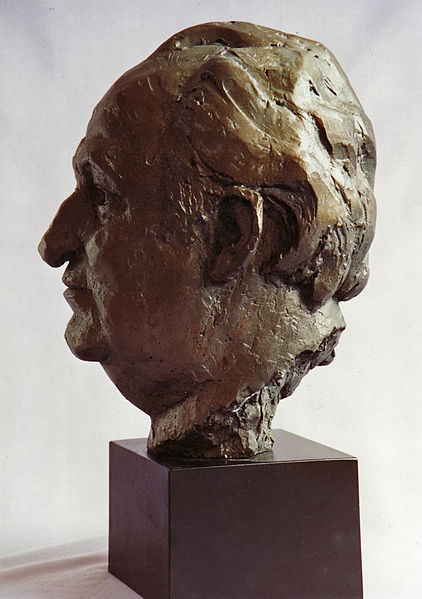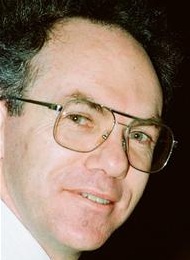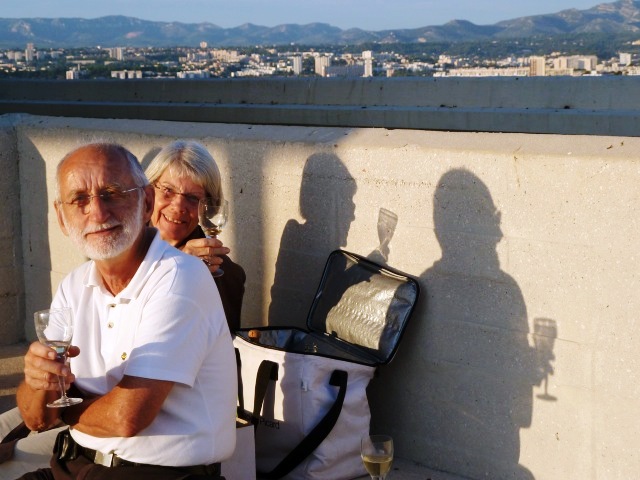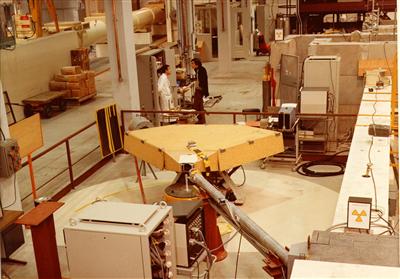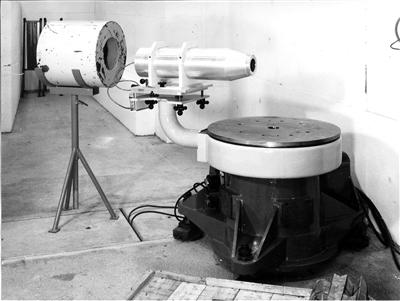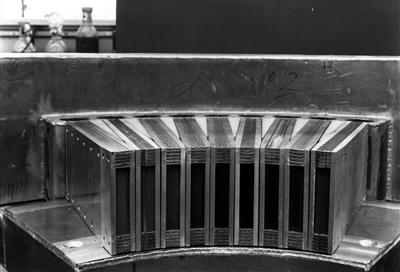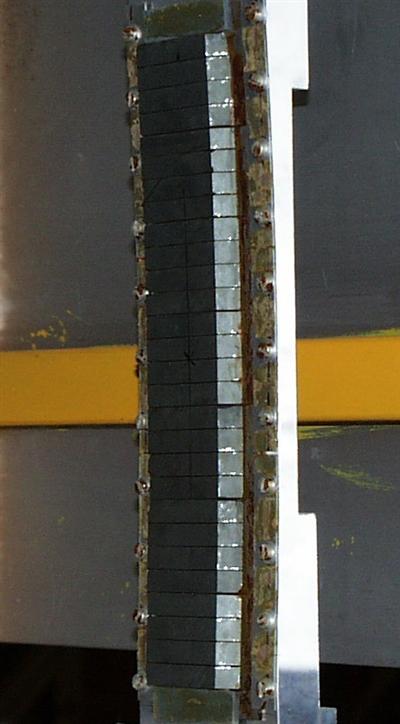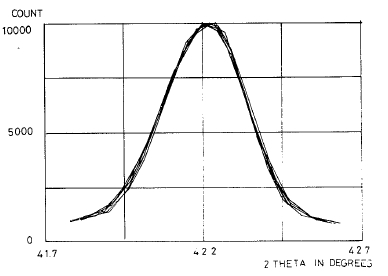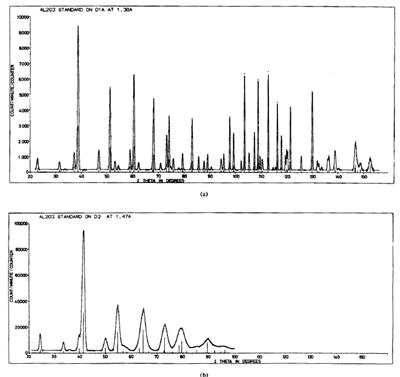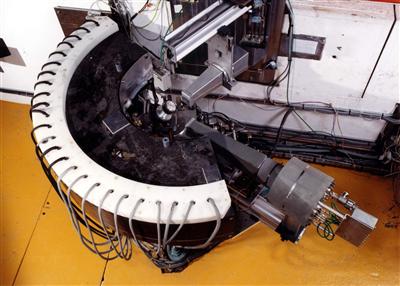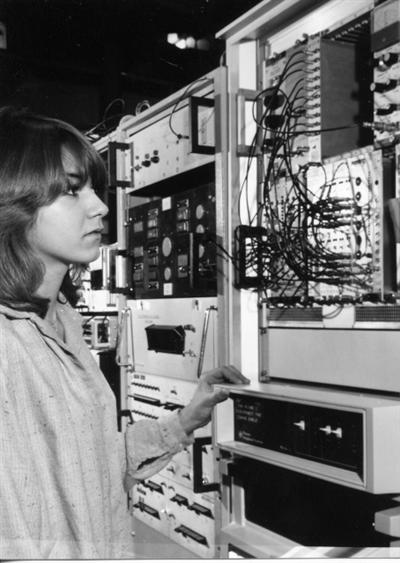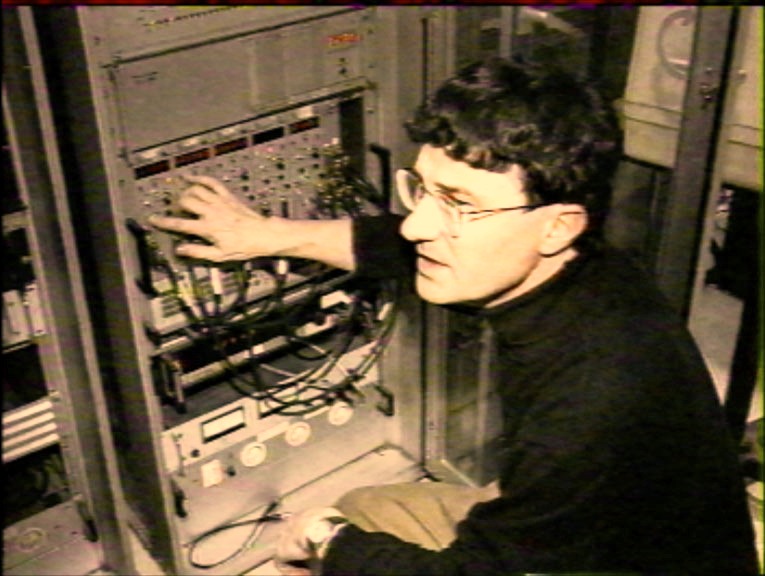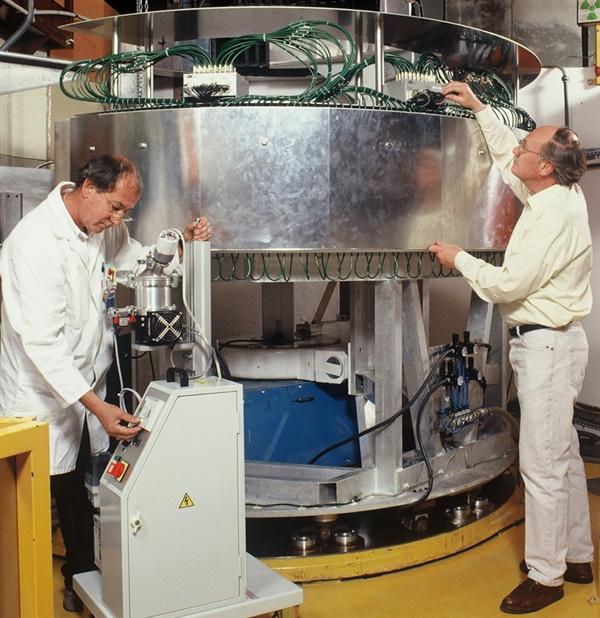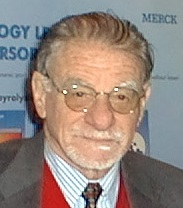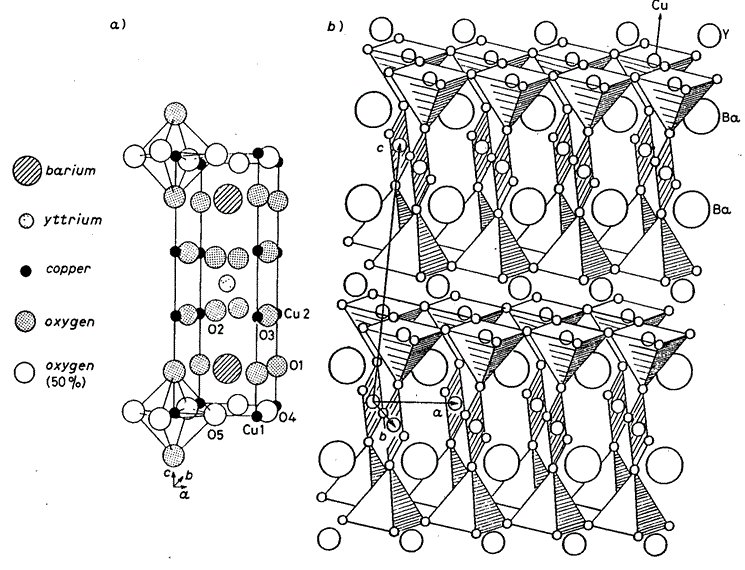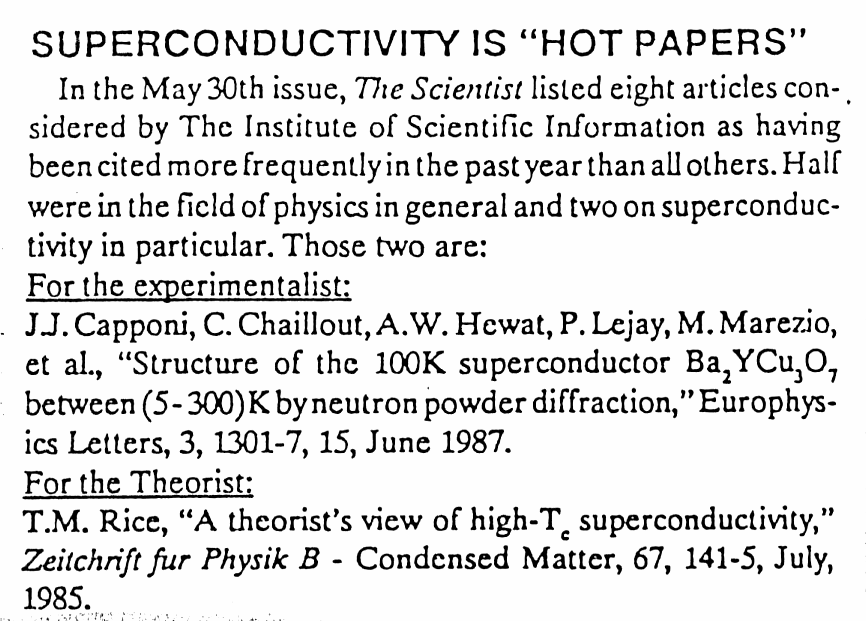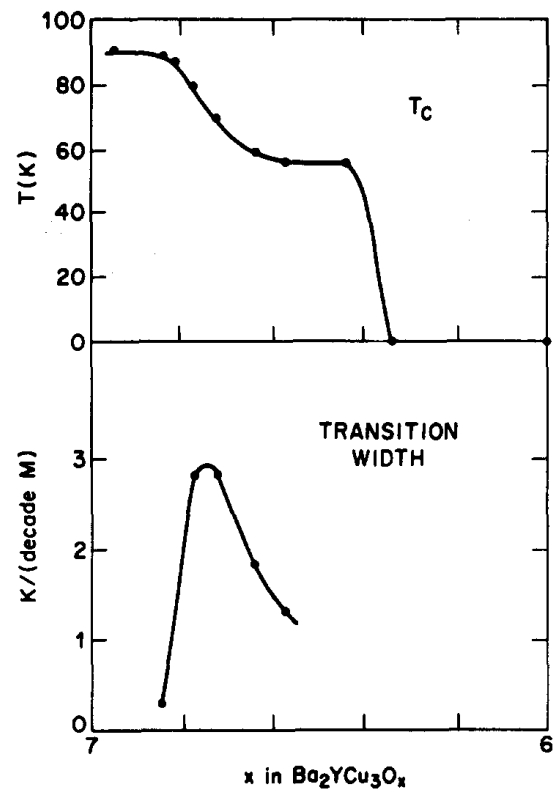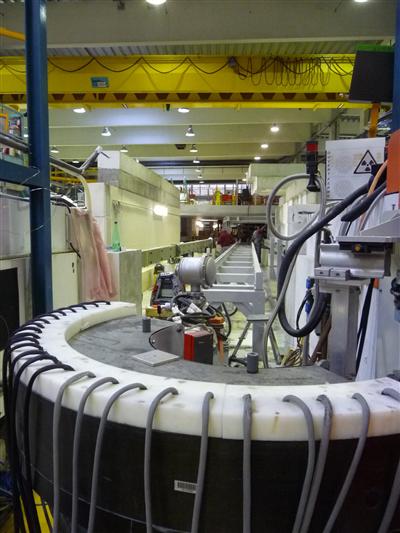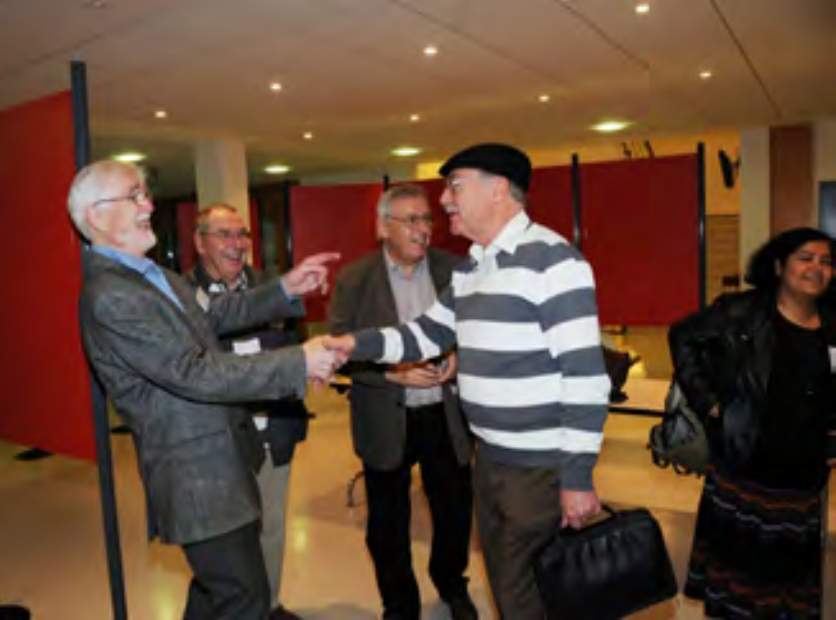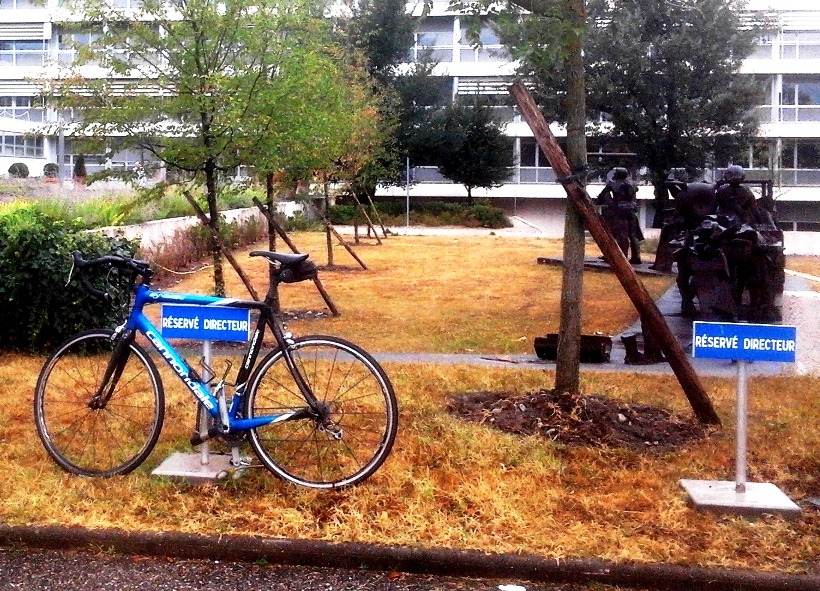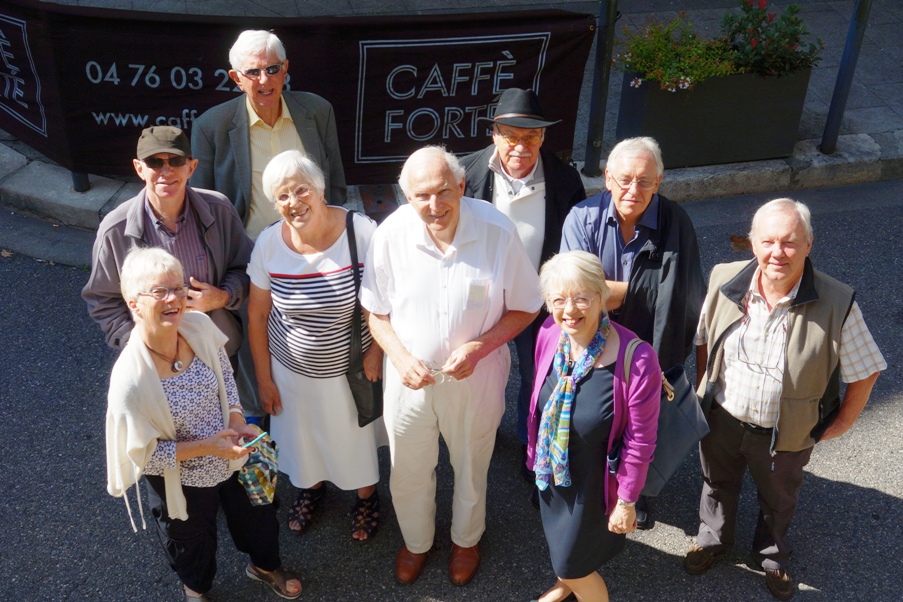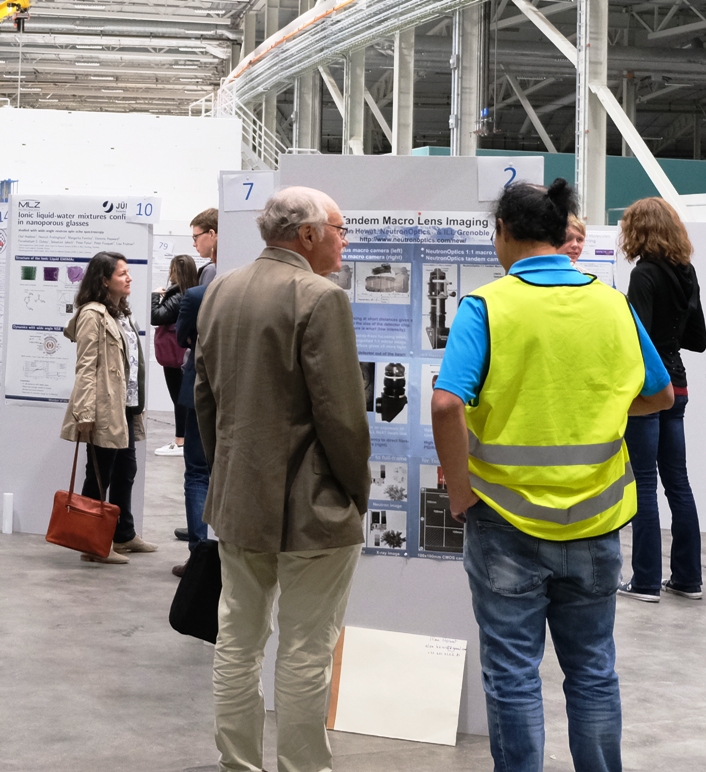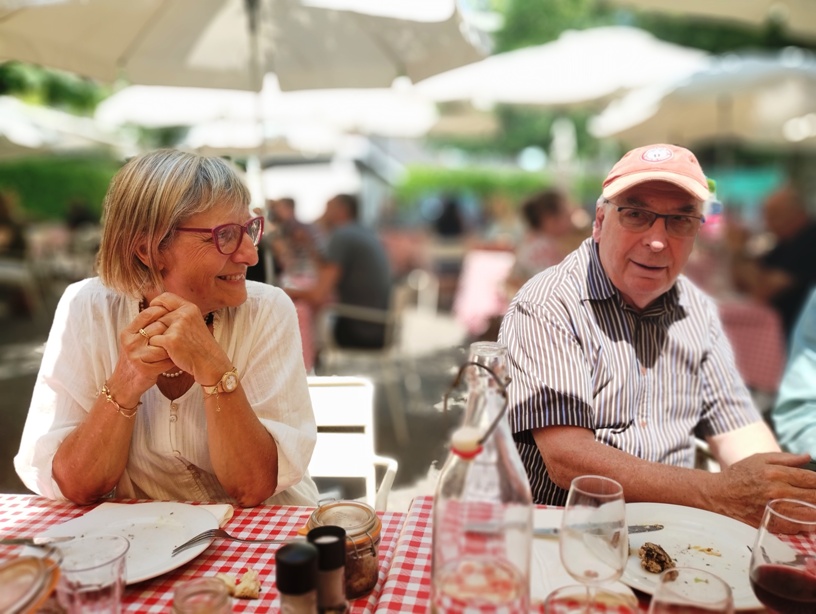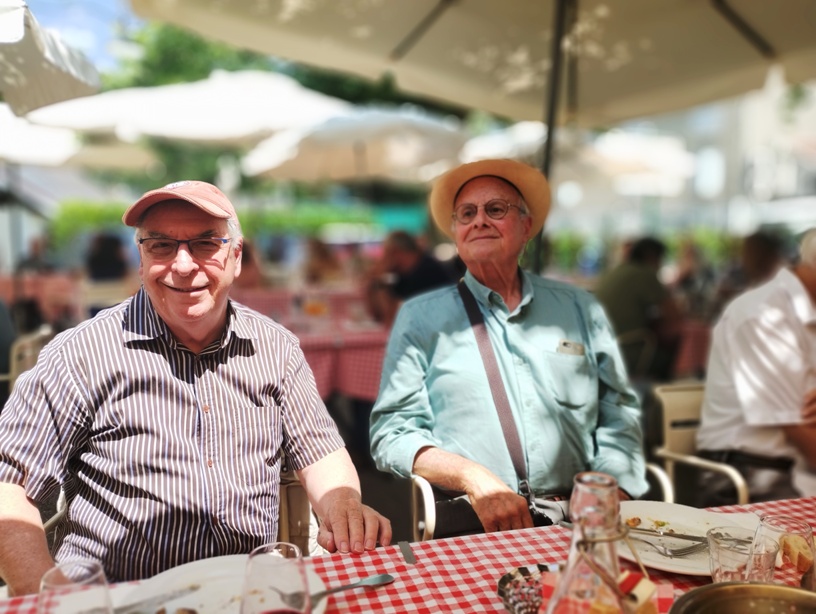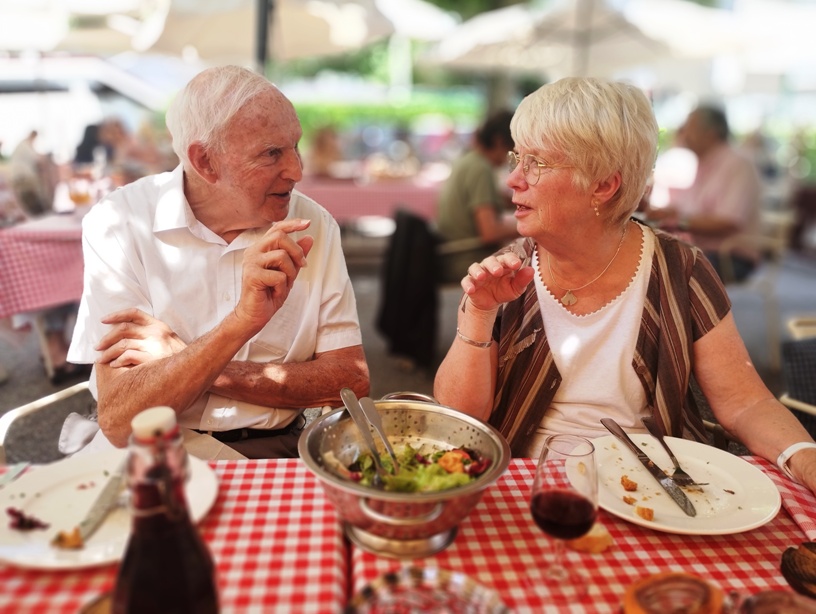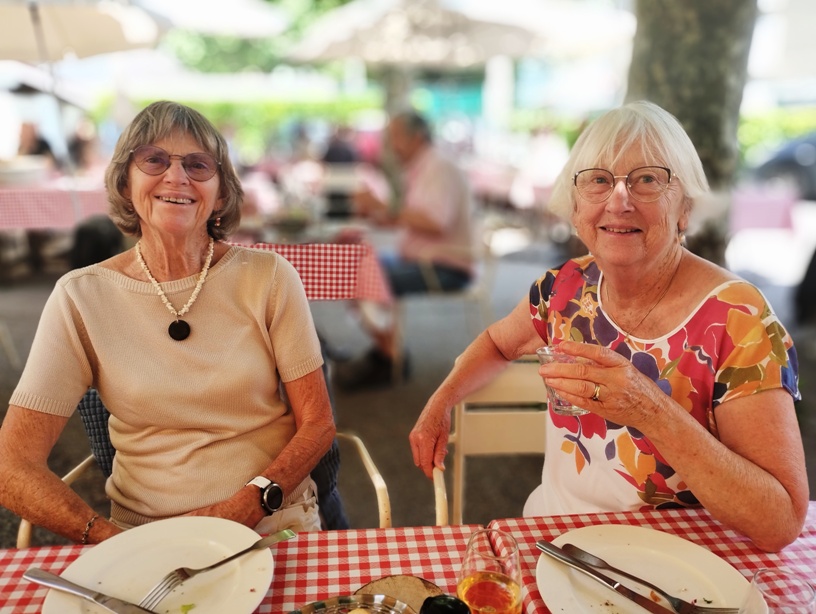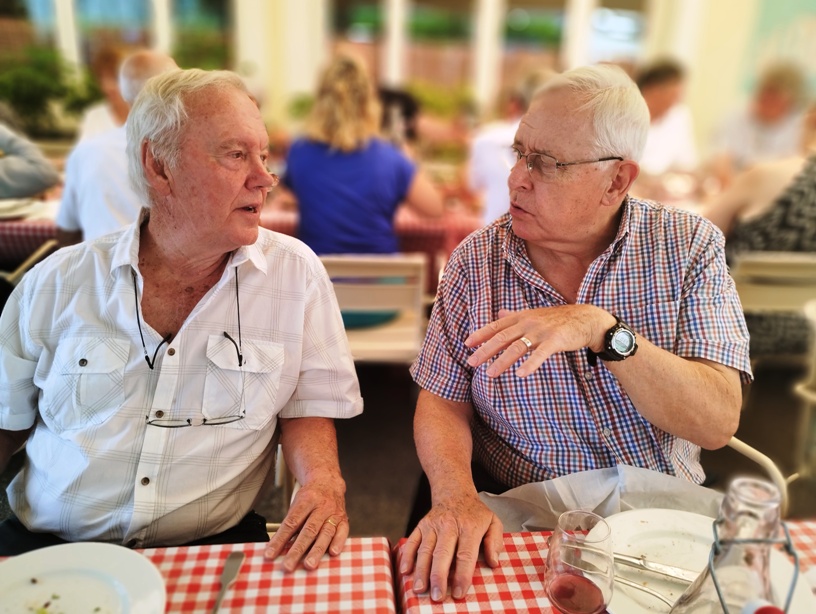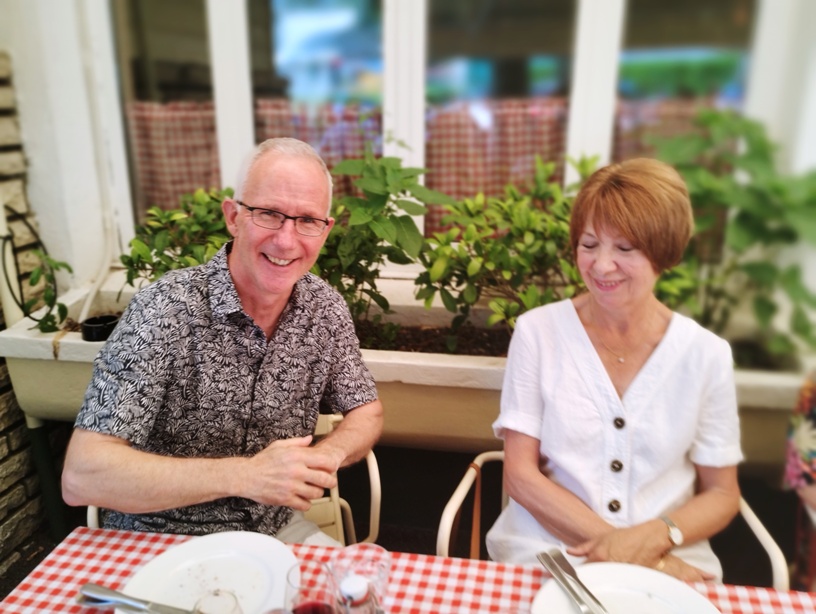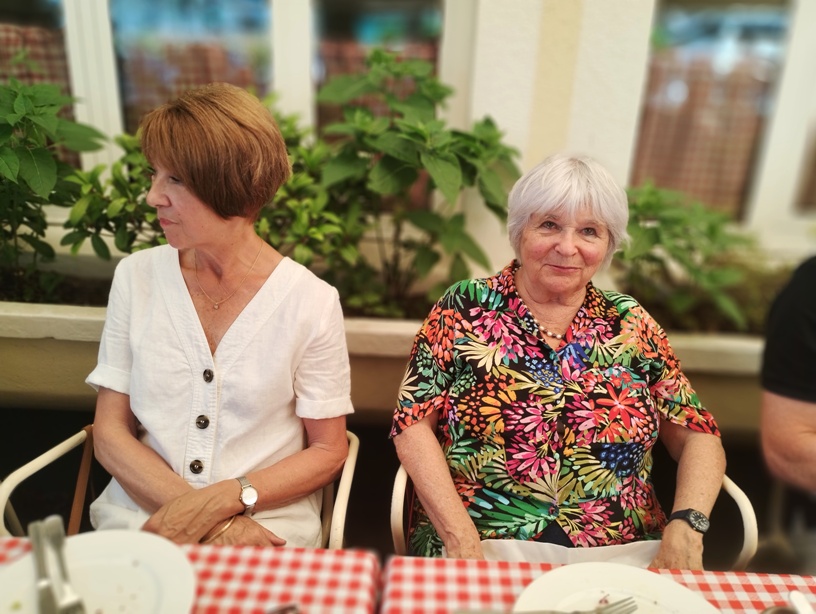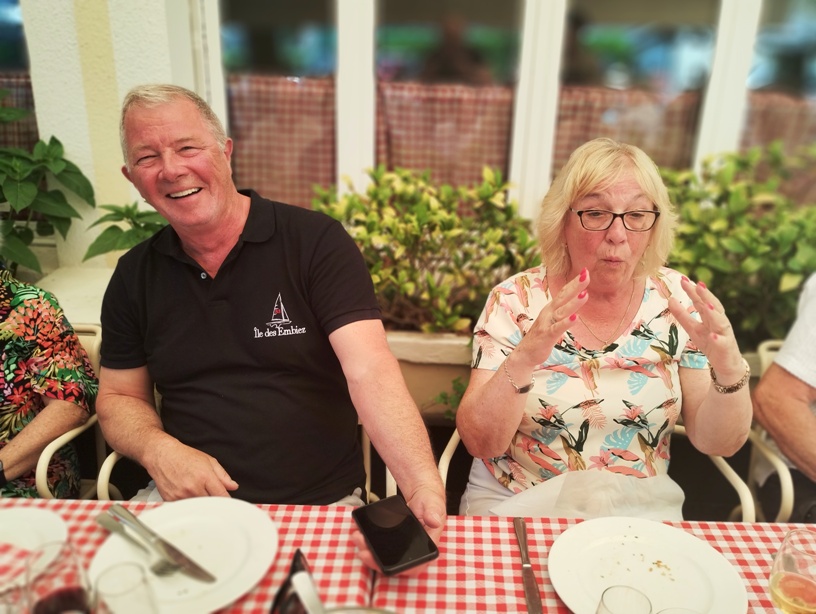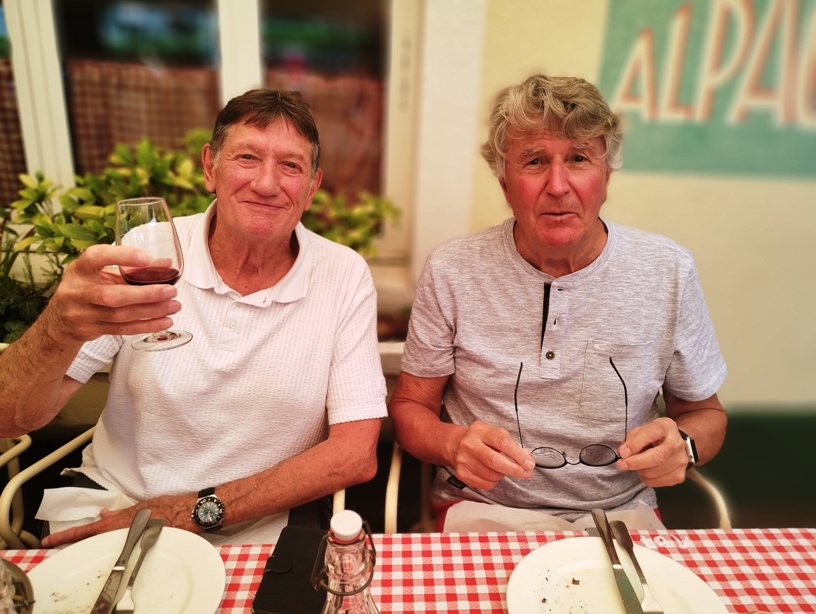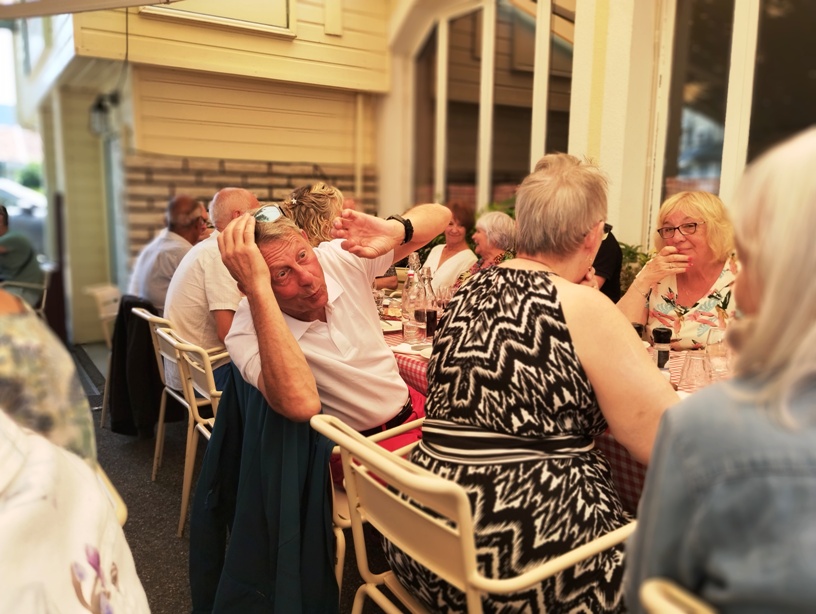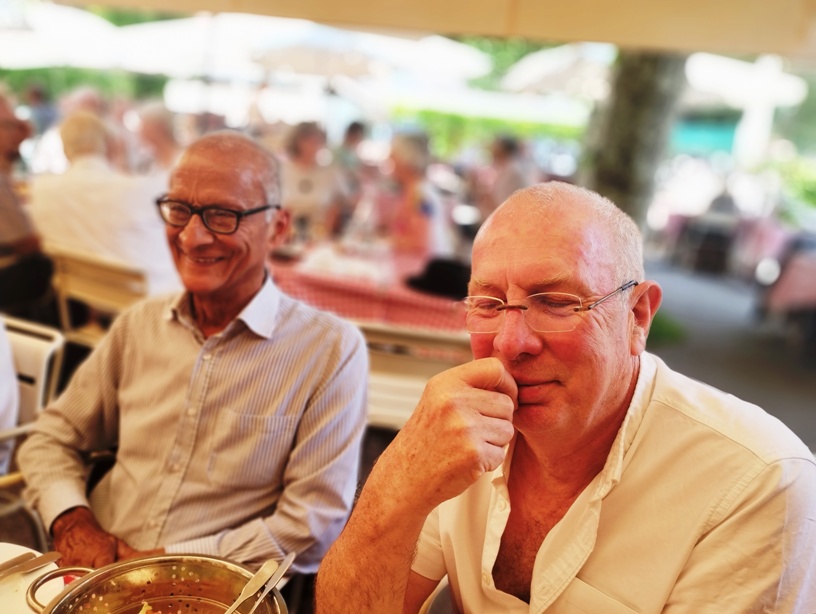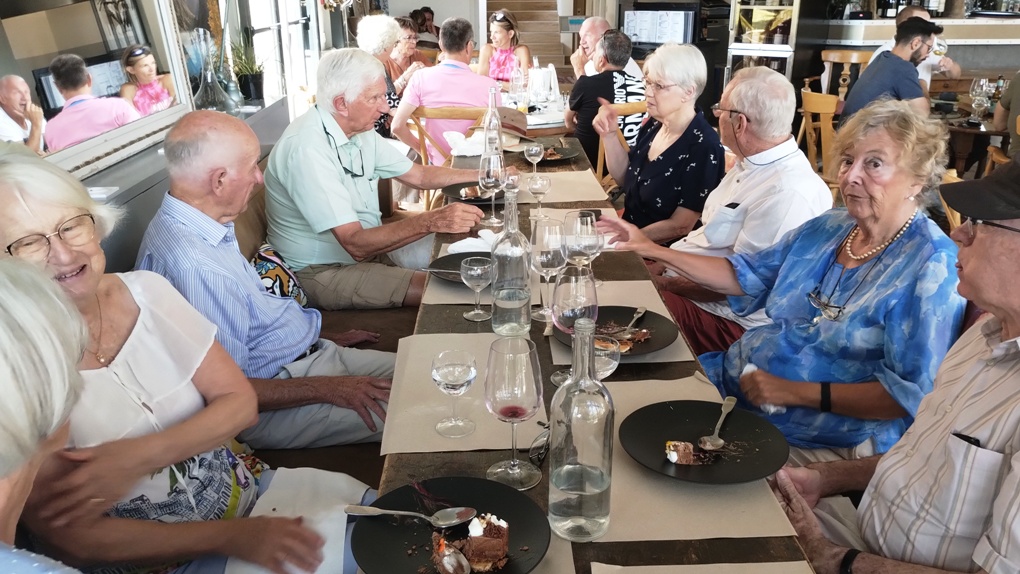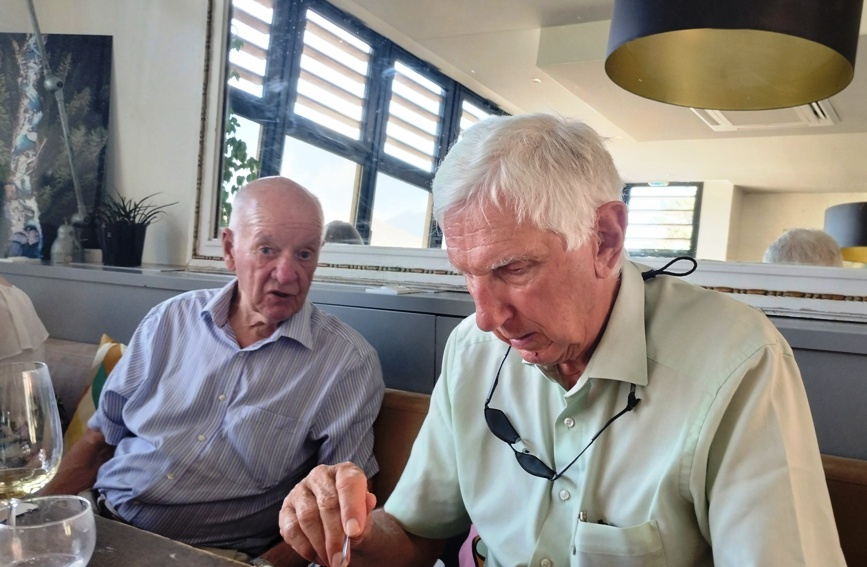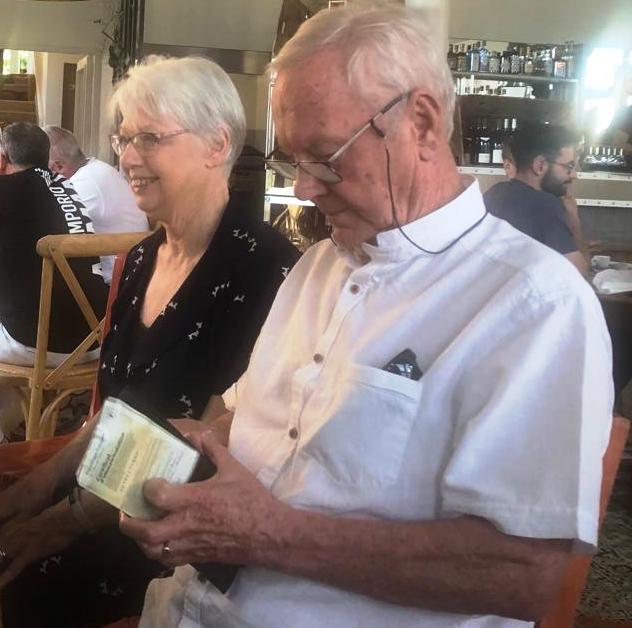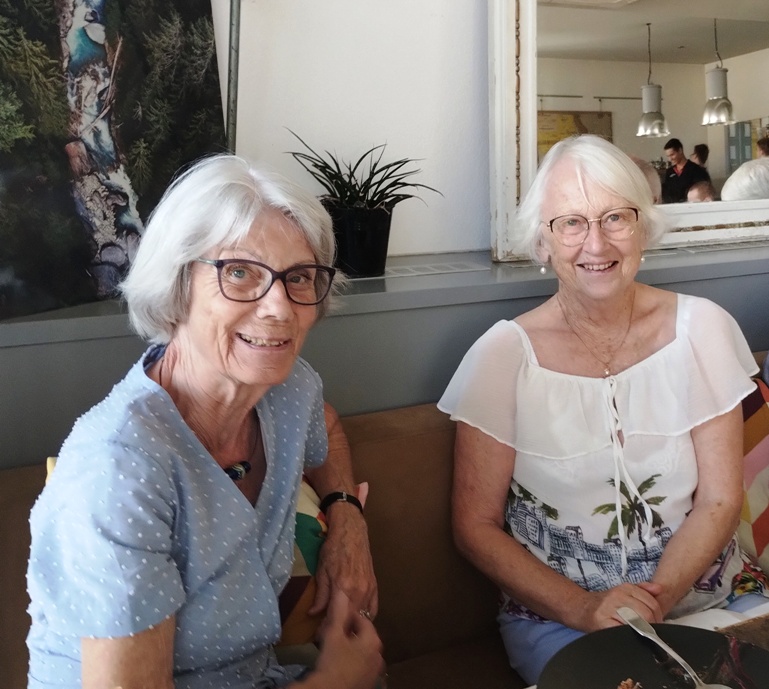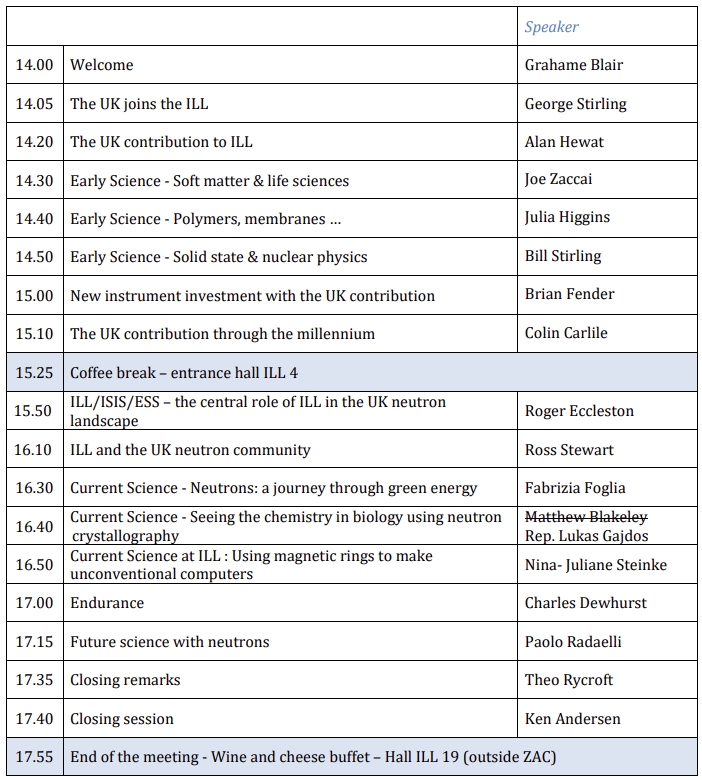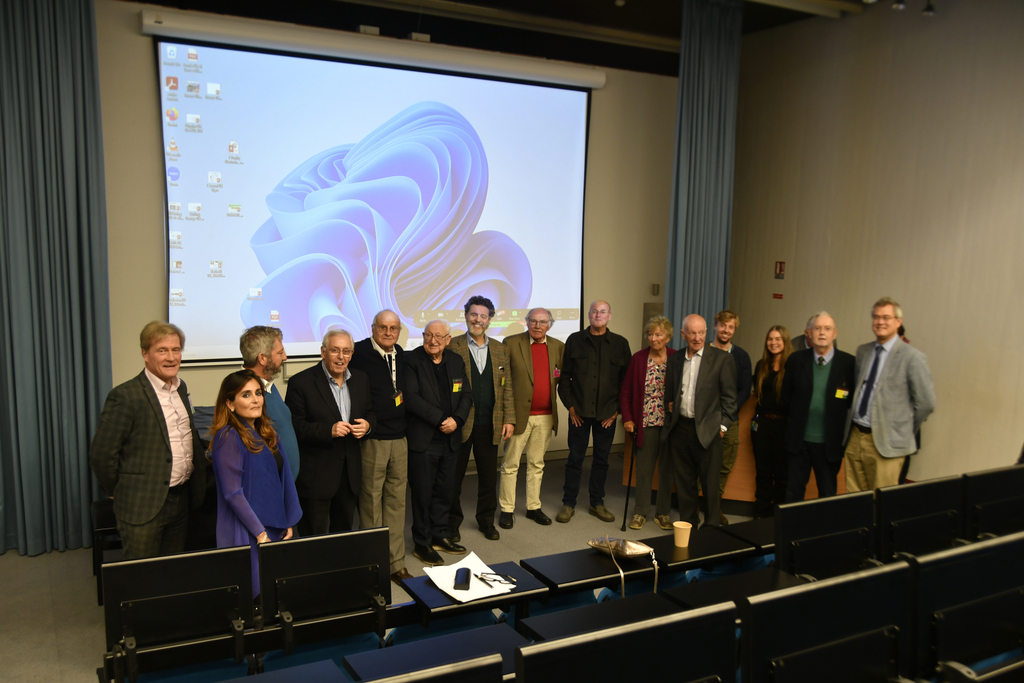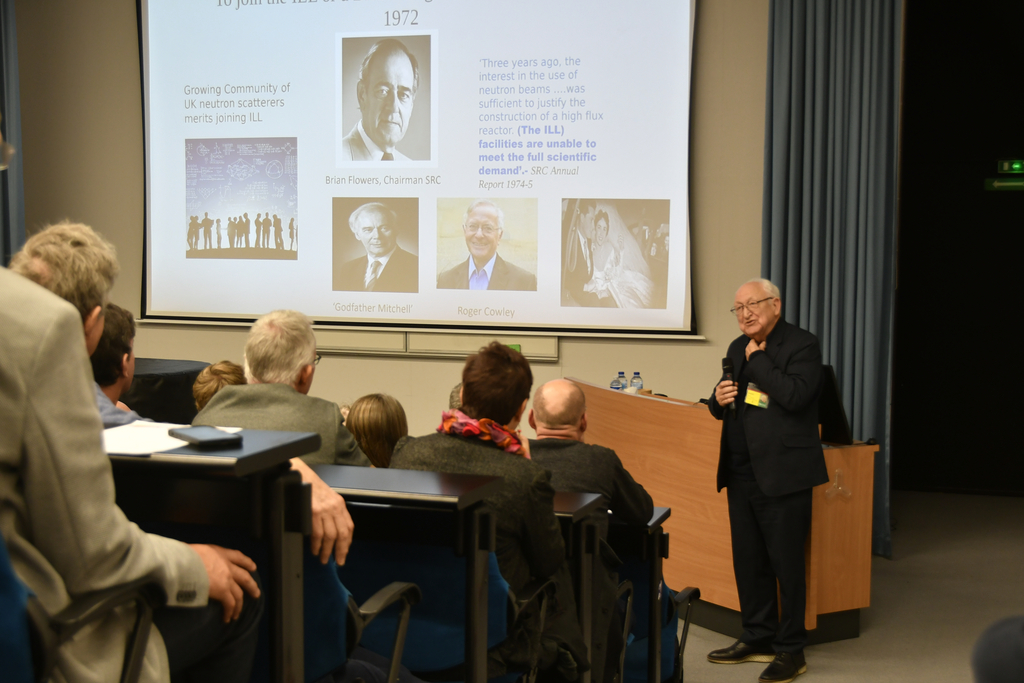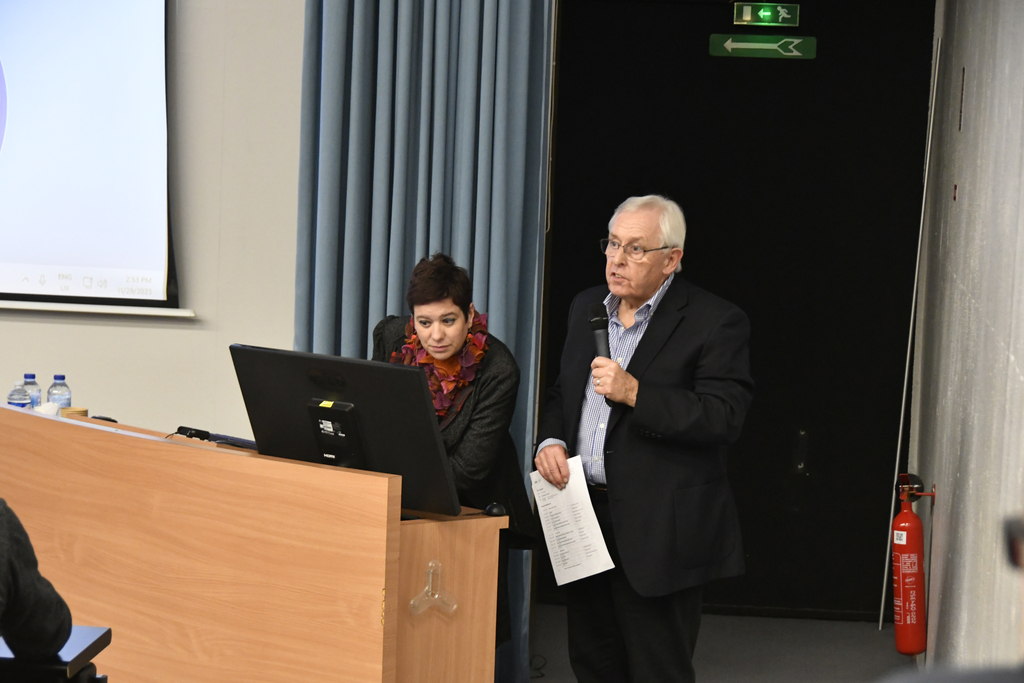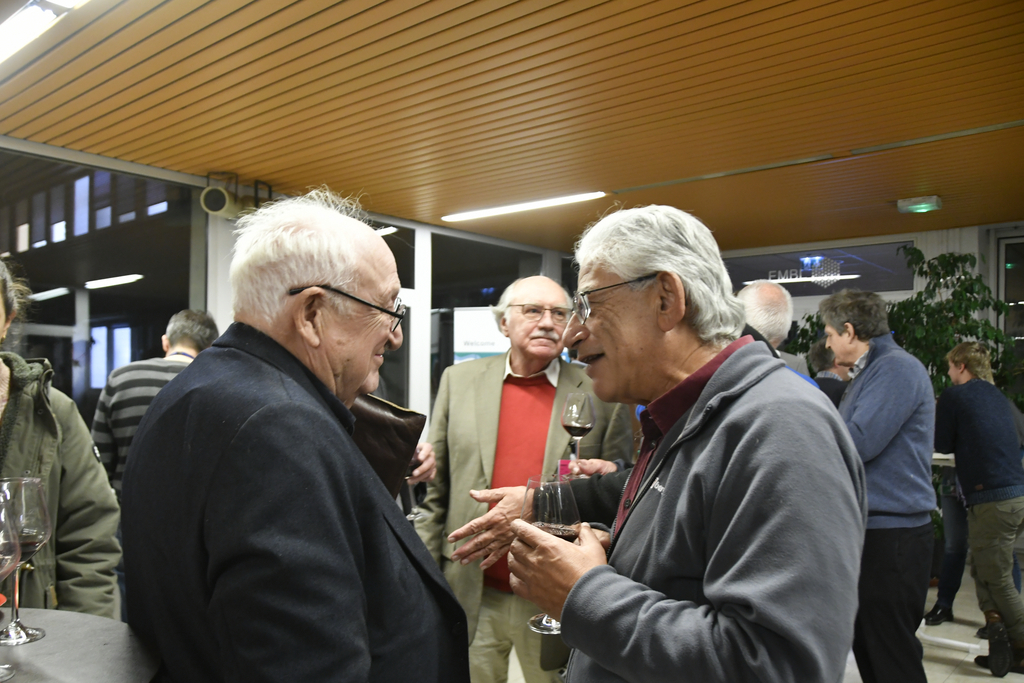History of the ILL from a personal perspective
Bernard Jacrot, the founding French Associate Director, has already written an excellent book on the history of the Institute from the perspective of a local participant in its construction. His history was summarised on the occasion of the ILL’s 30th anniversary, along with a biography of the founding German Director, Heinz Maier-Leibnitz by Tasso Springer and Toni Heidemann, his former students and long-time ILL scientists. The purpose of this essay is simply to describe my personal experience as one of the first scientists joining ILL from Harwell in the UK. This is an on-going work, being frequently modified and extended. Please email me with comments.
![]()
My introduction to Neutron Scattering from 1961
I completed my doctorate in 1970 at Melbourne University (Queen’s College) under John Maxwell Cowley FRS, an Australian who had been educated at W.H. Bragg’s former University in Adelaide, and then at M.I.T. Arthur Pryor, another Australian, and Margaret Elcombe a young Cambridge graduate, supervised my experimental work at the Lucas Heights reactor HIFAR in Sydney.
Cowley with Alec Moody at CSIRO invented the "dynamic diffraction" multi-slice method of computing electron diffraction images, for which they were awarded the first Ewald prize in 1987. In 1975 Cowley had written the book Diffraction Physics that Roland Gaehler at ILL has only now (2011) discovered with admiration. Cowley had had an education in modern optics at M.I.T., and taught his students all about Abbé imaging and Fourier transforms, using an optical bench, diffraction masks, analogue electrical computers and one of the first digital computers, a DEC PDP-8. These were excellent tools for many applications in Physics, apart from electron microscopy, which my wife studied for her thesis. Gaehler’s comment on the book 35 years later was “Those old guys knew everything. If only we had applied those ideas to neutrons at the beginning of the ILL”.
Pryor with Willis at Harwell wrote the book on Thermal Vibrations, and Terry Willis gave me Arthur’s manuscript to proof read when I arrived at Harwell. I had first worked for Arthur Pryor as a teenage undergraduate in 1961/62, computing Tables of Thermodynamic Functions on one of the first IBM mainframes. A man of few words with a cutting intellect, I remember that on my first day as a teenage boy for whom computers were the stuff of science fiction, he handed me a Fortran-II manual and told me that it was just like the law – I simply had to follow the rules. The only problem was that the rules were so strict. Each day I corrected my mistakes on the IBM punch-cards, and each day my “job” came back with a trivial error – and a summary of the cost of the computer time. My computing errors cost far more than they were paying me!
But Lucas Heights was rich in those days, and there was an on-site motel, complete with private swimming pool. I remember some time later, lying in bed in the morning and listening to the splashes of an attractive young lady, a fellow student from Melbourne, completing several lengths before breakfast. I also remember that when we met her brother in Sydney, her first words to him were that “I was not her boyfriend”. And that after I had bogged my car on the beach, trying to impress her, after chauffeuring her 500 miles from Melbourne.
Arthur Pryor was also a pioneer in the 1960’s of the computer control of diffractometers using an early PDP-8 with a memory of only 4K 12-bit words. Instructions were of course in machine language to maximise efficiency, with angular calculations taking only 163 words ! Yet this PDP-8 machine eventually ran two diffractometers at Lucas Heights ! When I arrived at Harwell in 1970, diffractometers were still being controlled by punched paper tape, using the system described in 1963 by Arndt and Willis. Incidentally, the first single crystal neutron diffraction measurement at Lucas Heights had been performed in 1961 on p-Diphenylbenzene by a young man from Ted Maslen’s lab. in Western Australia called Hugo Rietveld, and published in Nature with Terry Sabine.
Hugo Rietveld was soon to become famous as the inventor of the "Rietveld Technique", and he had an important impact on my scientific life, while Terry Sabine became well-known internationally and a good friend and colleague. Lucas Heights produced other scientists who went on to become friends and have important scientific careers, including John Parise a distinguished professor at Stony Brook (New York), who was a student of Margaret Elcombe. John used to joke about his childhood in a small Queensland town, with the plagues of cane toads; life was hard in those days :-) And when he visited Italy and the waiters disparaged him in the local dialect as "a crude American", he astonished them by answering back - in Italian. Lucas Heights also produced Dimitri Argyriou, now Director for Science at the European Spallation Source (ESS) the future world's most powerful neutron source. "Jim" was once passed over for a job at ILL - perhaps because there were already "too many Australians". Yet Colin Carlile admired his rich Ozzie accent, and often tried to imitate it, to put Australians in their place.
My thesis work was on the Lattice Dynamics of ZnO and BeO, beryllium oxide pellets being the moderator for the proposed Australian nuclear power reactor. Even though I had the biggest crystals we could afford, the inelastic count rate was something like 1 neutron per minute in a peak. Again the cost of the resources I was consuming (beam time), was much more than my graduate salary. In the early 60’s Terry Sabine was using cold neutrons at HIFAR, beyond the Bragg cut-off, to investigate the radiation defect structure in BeO. Terry once gave me a ride in his car, around the winding roads down from Lucas Heights. Never had I experienced anything like that ride, and never did I experience anything like it again, until years later I accepted a ride with José Dianoux at ILL.
Terry Sabine was an extrovert, imaginative and provocative. In many ways he was ahead of his time, and therefore out of step with the politics of the day. He famously crusaded for Australian enrichment of uranium, arguing that it was more profitable to sell a treated product than to sell raw uranium ore. This was at the time of a strong anti-nuclear movement in Australia. Even more provocatively he argued that Australia should not only enrich uranium, but should take back the spent fuel and bury it in the vast desert in the middle of the country. He would infuriate the anti-nuclear community by pointing out that most of the radiation they received was natural, or from medical x-rays, and that nuclear waste could simply be diluted in tarmac to pave the roads ! He never gave up with his nuclear energy campaign, but was equally convinced that Australia should invest in solar energy. On visiting foreign countries, he would immediately call the Australian Embassy and persuade them to extend their hospitality with a party. Bernd Maier, the German ILL Science secretary, was not amused when he visited, and as usual Gerry Briggs his British Associate had to smooth things over.
Today’s young students fly around the world to complete their experiments, but in the 1960’s I drove my old car back and forth, the 500 miles between Melbourne and Sydney on 2-lane roads, not always sealed. It took over 12 hours, and at 2am one night, half way back in the pouring rain, a passing truck threw a stone through my windscreen. The “safety glass” in those days immediately “crazed” and I had to quickly punch it out to see the road. The next 200 miles was rather uncomfortable with no windscreen, but there was no point in stopping, and I drove on with Sax and Ros Mason huddled in the back seat, trying to sleep in the rain. Sax was in Chemistry at Melbourne, having started University at the tender age of 15. We shared rooms in Queen’s College, were later in Oxford and Harwell together, and were the first “UK” scientists employed by ILL in 1973.
Of course, with coal resources for thousands of years, Australia never built the reactor, but the contact with Willis at Harwell secured me a job there, while Cowley’s contacts with Sir Peter Hirsch at Oxford allowed my wife to complete her doctorate there, living with me instead of following Cowley, her supervisor to Arizona ! We were married 3 days before we left for Oxford, touring North American neutron facilities en route, with an obligatory one-day honeymoon stop-over at Niagara Falls on our way to see Bertram Brockhouse. Brockhouse, who had been my external thesis examiner, gave us a splendid Canadian salmon dinner. He remarked that he had liked my thesis work on the Shell Model of thermal vibrations, but that I had been too cautious in not developing it further. He was right of course; I had spent too much time fascinated with the quantum theory of excitations and not enough on the actual experiments. I had even given a graduate course in Lattice Dynamics and Excitations, being most impressed with the book of Nozieres, whom I later met at ILL, long after I had become an experimentalist rather than a theoretician.
![]()
A young postdoc at Harwell, living in Oxford
My first impressions of England were how obscenely green it all was, and how hopelessly pessimistic the people. Probably the lack of sun and optimism are related. In the 70’s everyone in the UK knew their place, and Australians simply didn’t. At University I had learned to use a workshop to make equipment, but at Harwell only qualified technicians could do that. And not just any technician – each had his own speciality. So if a job required drawing, cutting, machining and welding, you needed four people. The workshops were out of bounds to scientists, who were supposed to occupy themselves with higher things. I finally found that there was one workshop I could use, a training facility “off site” and therefore beyond the rules. Scientists were to some extent above the law, but if anything went wrong, the full weight of it was applied. I once got into trouble for preparing samples in a glove box, and not being a chemist, I had used alcohol to clean it. A slow explosion of the dry alcohol vapour in the glove box singed my whiskers. With such a system, I understood why “string and ceiling wax” was a British scientific tradition.
At Harwell my task was to work for Terry Willis, with Bill Cochran’s student Joe Zaccai from Edinburgh, on the structure and lattice dynamics of ferroelectric materials. Terry was an excellent scientist with a remarkable memory, especially for people. He was different to the scientists I had known in Australia in that he relied on his assistants to construct the equipment and collect the data, concentrating on its analysis and publication. In that he was very skilled. But if his chief assistant, Keith Rouse, saw him heading toward the reactor with a screwdriver, he had to be intercepted or “harm would be done”. The distinction between scientists and technical staff was all part of the local culture, and was disappearing in the UK as it had already in Australia. It was a surprise to find the distinction still strong much later in France, between “cadre” and “non-cadre”.
David Wheeler, long-time head of the EDEX experimental service at ILL, told me about his time at Harwell when George Bacon was his boss. Bacon was naturally a kind and gentle man, but he could walk past David’s desk in the morning and never even say “hello” unless he had something serious to speak about. David left Harwell for Lucas Heights in 1965, and certainly lost some of his English culture in the more relaxed Australian environment. After he returned to take an ILL post in 1974, he of course met George Bacon when he visited. David says that the relation was then very different, with George delighted to find an old friend in a foreign country. David himself must have found the French “cadre” distinction reminiscent of his Harwell days. Although many consider David Wheeler a pillar of the early ILL, as a non-scientist he is not mentioned in Jacrot’s history.
Cochran in 1960 had shown that the dielectric properties of a ferroelectric depended on an instability developing in the lattice dynamics: for certain modes of vibration (soft modes) the inter-atomic forces are so evenly balanced that, when the temperature is lowered the balance is upset, and one or more of these soft modes ‘condenses’ to produce a change in the crystal structure. The problem was that the structural transition usually breaks the crystal, so it was difficult even to measure the structure, let alone its lattice dynamics. After first trying to use electric fields to produce single crystals of perovskite ferroelectrics, I decided to simply break up the crystals and look instead at the resulting powder patterns.
Certainly there were huge changes in the powder pattern for small changes in the structure, and with my early experience of computing I tried to extract that information. George Bacon, who wrote the book on Neutron Diffraction, was quite interested, and remarked that some chap in the Netherlands had already been working on just that problem. It turned out to be Hugo Rietveld, the Dutch-Australian who had worked with Terry Sabine at Lucas Heights. I visited him and brought back a copy of his computer program, which I modified at Harwell with Bruce Forsyth to allow it to describe the strong anisotropic vibrations due to Cochran’s “soft modes”. That source code was distributed to Brian Fender and his students Tony Cheetham and Bob von Dreele at Oxford, and to many others, and was the basis of most of the subsequent refinement programs.
Near the end of my contract, I applied for a position at Cambridge, where Helen Megaw had worked on the structure of perovskite phase transitions, in particular barium titanate. I was invited to give a lecture, and talked about using powder diffraction to understand phase transitions. Jane Brown was in the audience, and kindly asked a question. But later at ILL, she put me in my place with her remark “powder diffraction - if you’ve seen one you’ve seen them all”. Jane was a formidable member of any audience. She would sit at the front, appearing to be asleep, and then wake up and ask an awkward question. Or else she would show obvious embarrassment when I did something “Australian” for which I should myself have been embarrassed, but wasn’t. I didn’t get the Cambridge job, but suppose that it was because Cambridge, where so much had been invented in crystallography since the Australian Braggs, had decided that the subject was no longer fundamental. Jane herself left Cambridge for ILL shortly after.
I remember that at the 1975 IUCR neutron meeting at Petten, I was asked at the last moment to take part in a debate on “Powders verses Single Crystals”. Petten was of course the home of Hugo Rietveld, but he was not there to defend himself; Hugo, perhaps disappointed that his work in neutron scattering had not achieved the recognition he desired, had applied to become head of the Petten library !
Immediately before I spoke, George Bacon, rose with his lecture notes and said.....
"Gentlemen, I have here the results of 60 years work in crystallography using single crystals" … (tearing up and dropping his notes) …"and that is powder diffraction!"
As a young man debating with the leader in the field, I was lost for words, but that night in bed, I lay thinking of what I should have replied. I should have picked up the pieces and said:
"Now I can do my powder experiment … and Professor Bacon can do his experiment … (dropping them) … when he puts them together again!"
The best ideas always come too late, and Bacon’s dramatic gesture was after all a compliment. Like many crystallographers brought up on the idea that “structure factors” were essential, and best obtained from single crystals, Bacon no doubt believed that powder diffraction was necessarily inferior. This was to under-estimate the power of digital computers to make many of the beautiful analytical crystallographic techniques obsolete, just as they had for mechanical and analogue computers. “Rietveld Refinement” as Terry Sabine later christened it, was such a success that during my 3-year Harwell postdoc I produced 19 papers, including one in Nature on the application of powder diffraction to hydrogenous anti-ferroelectrics such as ADP. This was enough for me to be recruited to the European High Flux reactor (ILL) by R.L. Mossbauer in 1973.
![]()
The European and British High Flux Reactor Projects
When I arrived at Harwell in 1970, an agreement had already been signed in 1968 between France and Germany for the construction of a European High Flux Reactor, to be called the Institute Laue-Langevin (ILL). The UK had earlier been negotiating with France for the construction of such a reactor, following the success of the high flux neutron sources at Brookhaven (BNL) and Oak Ridge (ORNL) in the U.S., but the UK dropped out when it proved difficult to obtain funding - and to persuade the French to locate the reactor in Britain ! Sir Brian Flowers, chairman of the UK Science Research Council and Harwell Director Sir Walter Marshall had negotiated the scientific case.
Harwell had largely pioneered neutron scattering after the war, along with laboratories in the U.S. and Canada, building two excellent materials testing reactors DIDO and PLUTO in 1956-7. Copies of these reactors were built in Australia (1958), Germany (1962) and Denmark (1962). Harwell had also pioneered neutron diffraction (G.E. Bacon) and time-of-flight inelastic scattering, inventing both cold and hot neutron sources (P.A. Egelstaff). Harwell, following Lucas Heights, had developed the “University User” system of allocating neutron beam time, which meant that the UK neutron community was easily the largest in Europe. Yet after the war France was determined to build up key national industries, in particular the nuclear industry, and Germany naturally wanted to be part of this new Europe. In January 1963 De Gaulle and Adenauer had signed a wide ranging treaty providing for political, scientific, cultural, and military cooperation, while in the same year de Gaulle blocked British entry to the EEC.
After the UK withdrawal from the project, France and Germany agreed in January 1967 to build a Franco-German reactor in France, and the compromise site was Grenoble, rather than a border location like Strasbourg. Grenoble had strong local champions in Nobel laureate Louis Neél, who had already built up a neutron laboratory at the CENG, and Felix Bertaut at the national CNRS laboratory next door. The German champion, Heinz Maier-Leibnitz was based in Munich, and felt a certain affinity with another Alpine city. Since it couldn't be Munich or Paris for political reasons, for once the scientists got their way.
I remember that soon after I arrived at Harwell in 1970, a small group including Bruce Forsyth was transferred to the Neutron Beam Research Unit at the Rutherford laboratory next door, to prepare for the construction of a rival UK High Flux Reactor for academic research, championed by Peter Egelstaff and Bill Mitchell at Reading. But two important events had already occurred that were to put an end to this ambitious project described by Egelstaff in 1970; de Gaulle had been forced to resign in 1969, and with him French opposition to the UK joining Europe; and in 1970, Edward Heath, a pro-European was elected UK Prime Minister. This time the scientists were over-ruled.
The Franco-German reactor was a "simple" swimming pool design where the water-cooled core, which also moderates the neutron energy to maintain a chain reaction, is immersed in a pool of water that contributes to neutron thermalisation and cooling, but mainly serves as radiation protection. There was a debate as to whether the core should be cooled by ordinary water H2O as used in the US, UK and France, or by heavy water D2O proposed by the Germans as a more effective moderator. Finally Robert Dautray, the French head of the design team, chose re-circulated heavy water cooled in an ordinary water pool by a heat exchanger. The 57MW design power of the reactor was modest, but the power density was high to provide a high density of neutrons 1.5x1015 n/cm2/s. The reactor core therefore looks like a small (stationary) turbine, with high speed heavy water circulation. The need for large tangential beam ports to accommadate guides was also a design advantage over the earlier reactors, since they provide much higher solid angles even with beam tubes, important for focussing monochromators.
The British reactor had been designed 10 years earlier, modelled on the Brookhaven HFBR, and was supposed to operate at 100MW and also provide 1.5x1015 n/cm2/s using an Al/U alloy cooled by pressurised heavy water. It would have naturally had hot and cold sources and lots of beam ports, both horizontal and inclined, but no neutron guides, and powder diffraction was not even mentioned in the 1970 Nature paper. There would be "several time of flight spectrometers, several three-axis neutron spectrometers as well as diffractometers for single crystal analysis. Other specialized instruments for long wavelength work and defect studies are proposed, making in all twenty-seven different spectrometers." Mick Lomer later confided that the lack of guides would have been a big mistake, and the inclined beam tubes were finally much less useful than had been imagined. The UK with its much greater user experience, would have built more productive instruments from the beginning, but the Franco-German reactor is still the highest flux neutron beam reactor in the world. Though even a factor of x10 in source flux became less important when instrument efficiencies eventually improved by factors of x100 or more.
Although neutron guides are the analogue of optic fibres, which had been used since the mid 20th century, and the principle of light transmission by total internal reflection had been demonstrated in streams of water a century earlier, neutron guides were discovered only in ~1961 by accident. Toni Heidemann, a contemporary at ILL and Maier-Leibnitz's student, told me how Tasso Springer had been asked to prevent people walking through the beam of his small angle scattering machine at the old FRM in Munich. Springer used a brass tube to enclose the beam - and discovered that he then had more neutrons !
Once the principle had been recognised, guides were improved with internal nickel coatings, and later with multi-layer coatings to increase the effective critical angle by constructive interference. The neutron guide was perhaps the single most important advance in neutron scattering technology since the 3-axis spectrometers and powder diffractometers that won the Nobel prize for Shull and Brockhouse.
There is an interesting debate on the interest of neutron guides in an IAEA paper by Jacrot in ILL’s 1969 Annual report. The participants included Egelstaff, Brockhouse, Mook, Dolling, Brugger, Riste and others sceptical about the advantages of reducing the background and increasing the solid angle with guides. Egelstaff commented in particular:
“Perhaps I could summarize the advantages of guide tubes. One major gain is that you get five beams on one hole rather than one or perhaps two beams. Each beam has a lot of working space and a low background. Another point is, suppose you want very high resolution with a crystal spectrometer. You must cut that 1o down to 0.5o or less to get very high resolution, which gives a loss compared to your time-of-flight system. You get the 1o on any flight path of a time-of-flight system, because you never reduce the collimation when you improve the resolution”.
The practical advantages of guides were understood, especially for cold neutrons, but there remained a lot of confusion about background, intensity and time-of-flight vs crystal spectrometers on guide tubes. Riste insisted that with graphite monochromators all in a row you could also put five machines on one beam tube. This was not tried until much later with 3 first class instruments, D19, D20 and D2B all on the same H11 beam tube, not with graphite monochromators, but with the beam divided horizontally.
Meanwhile the Nobel laureate R.L. Mossbauer, a former student of Maier-Leibnitz, had become Director of ILL, and held a different view of the purpose of the new Franco-German laboratory. Maier-Leibnitz had the ambition to make the ILL a world leader in neutron science and technology. But his student Mossbauer saw the ILL more as a service to the scientific community, much as the Harwell reactors had become in the UK. I remember seeing Mossbauer, soon after he became Director, visiting Harwell in early 1973 to learn how to set up a neutron user facility at ILL.
![]()
The UK joins Europe and ILL & send in the infantry
Then at the end of my postdoc in 1973 the UK finally joined the European community, and also the Franco-German ILL laboratory. Scientific collaboration is always easier to agree about than politics, and apparently the French and Germans had promised the British that the next neutron source would be in the UK. Promises, promises... The British found that the cost of joining ILL was much higher than they had hoped; they were required to pay 1/3rd of the total investment, the same as the host nation, without of course having been able to bid for any of the construction contracts or decide on any of the instruments. Originally UK scientists had asked for only a small part of the ILL beam time, until the new UK reactor was ready, but the French refused that, and with the cost of ILL membership, there was no money left for a UK reactor, even if it had been politically possible.
At Harwell they joked that with the extra UK money, the French were able to build a second reactor, Orphée in Paris, starting in 1975! Although one must admire this political “coupe de force”, it did little to renew the “entente cordiale” that the European project was meant to promote. For decades afterwards some in the UK threatened to unilaterally reduce their contribution or even to pull out altogether. Of course such decisions are not made at the scientific level, but in London and Paris. Today the French reactors in Paris and Grenoble have been shut down, while the UK continues to improve ISIS, their own neutron source. And a former ISIS scientist promotes the next European neutron source, not in the UK as “promised”, but in Sweden and Denmark, who also shut down their own sources for "safety reasons". But scientists are great opportunists, and “all neutrons are good neutrons”.
Incidentally, the success of ISIS, only a medium flux source but with excellent instruments, and the success of the various instrument renewal programs at ILL, have demonstrated that perhaps size does not matter so much for neutron sources after all; size is useful, but how it’s used is more important. At the 2010 ILL Millennium Symposium, the Director stated that ILL’s modest investment in instruments had resulted in a x19 gain in efficiency, while the average gain expected from a new neutron source would only be about x5.
Along with Sax Mason, another Australian in Oxford, I had been one of the first “UK scientists” to be recruited to ILL in 1973, along with the young Bill Stirling and Julia Higgins. It is always difficult to relocate established scientists, so the first recruits were naturally recent graduates or colonials. However, Mick Lomer from Harwell became UK Associate Director, and Jane Brown from Cambridge followed in 1974 as UK Senior Scientist. Although I was appointed with the first intake in 1973, I delayed my departure from Harwell until September because Elizabeth was still finishing her thesis with Colin Humphries at Oxford, while at the same time producing our first baby. That didn't matter because very few of the original ILL instruments were actually working.
Bruce Forsyth, having had to relinquish the dream of a new UK reactor, remarked on first visiting ILL that “he was very impressed by one instrument, D5, and even more so when he found that that was just the beam stop”. Indeed the original ILL instruments were built to be “unique in the world”, and it was only with some difficulty that local scientists such as Bertaut could secure the construction of a few simple diffractometers that could be used by the scientific community.
It is remarkable that the ILL reactor was built by some of the most experienced and talented nuclear engineers of the day, and even 50 years later, it would be difficult to do much better. But the original ILL instruments were designed by students, inexperienced with the application of neutron scattering to real materials. The contrast between the work of the experienced engineers and the amateur scientists was striking. Fortunately, two great scientific inventions saved the reputation of the scientists - neutron guides and position-sensitive detectors.
The local CNRS-CENG labs saw that it was not enough to build “the world’s most powerful neutron source” but invested also in building better detectors. The simple powder diffractometer D1B, with Pierre Convert as responsible, was one result of that effort, with its remarkable position sensitive neutron detector. D1B has in fact been more scientifically productive than any other ILL instrument, whether one counts the education of students, the number of scientific publications, or even the number of papers in “high impact” journals. The small angle scattering diffractometer D11 was another early ILL success that profited from the local investment in position sensitive neutron detectors.
Having completed my thesis on inelastic neutron scattering and lattice dynamics, and converted to elastic scattering and diffraction at Harwell, I was astonished to see most of the other instruments. D2 was a very simple diffractometer, with enormous intensity close to the high flux reactor, but very poor resolution. The idea of focussing neutron energies at high monochromator angles was apparently unknown to its design. Similarly, IN2 was a simple 3-axis machine with excellent signal/noise ratio - but very little signal. A 4th axis with a second monochromator had been added, apparently with no understanding of the concept of energy-momentum focussing geometry that was the basis of Brockhouse's original machine.
I remember that in my first week in Grenoble, a meeting was held by ILL scientists angry about decisions that had been made by Mossbauer. The ’68 “revolution” of France and Germany had had much less social impact in the UK, and I was astonished to hear young ILL scientists publicly criticising their Directors in a most aggressive way. Mossbauer himself had had the good sense to be called to urgent business elsewhere, leaving Mick Lomer to face alone the angry assembly. He must have been as astonished as I, but looking so vulnerable in front of the crowd, he managed to calm things down before the German Director returned.
Mossbauer was a very different man. Young enough to have sympathised with the ’68 revolution, but old enough to have grown up under a very grand German Professor in Maier-Leibnitz, he was greatly strengthened by his Nobel prize. He used to joke that when he stood alone against the Steering Committee, and all seemed lost, he would pull out a copy of his letter of resignation, and tell them that “my secretary has the original, already signed, and I just have to pick up that telephone…”
![]()
The ILL Steering Committee
The Steering Committee represented the interests of the three Associate countries, and also determined the ILL budget. They might be compared to the Board of Directors of a private company, as the ILL is under French law, and indeed in French they are called the “Comité de Direction”. But the Board of Directors of a commercial company are themselves business experts, able to provide technical advice to the Executive Director. The members of the ILL Steering Committee, while expert managers, are usually not practising scientists. The Steering Committee might also be compared to a Board of Auditors, ensuring that the Associates’ money is well spent, but in practice the Steering Committee appoints specialist auditors to help them in that task. The role of the Steering Committee is somewhere between the two. They are mainly concerned with allocating the budget and ensuring that it is well spent, but there are some technical questions where they may reasonably intervene.
A classic example concerned the choice of computers for the ILL in the 1970’s. European governments had a policy of favouring the growth of the local computer industry, so it was natural for the Associates to try to influence the ILL’s choice. But the ILL Director, at that time Mossbauer, naturally had more knowledge of the best technical solution. Finally the Director had his way and purchased American computers as well as French computers, but not without great difficulty. Controlling the budget makes the Steering Committee a powerful body. They themselves appoint the Director, so have an interest in seeing him succeed, and of course in seeing the ILL succeed.
I myself never assisted at the meetings of the Steering Committee, but of course I knew some of the participants, both on the management and on the staff union sides.
![]()
The ILL Science Council
The Science Council represent the interests of ILL users, and advise the Director about Science policy, but have no executive responsibility. Originally they were chosen as experts independent of the scientific programme, but then the chairmen of the experiment selection committees were invited to ensure that user demand was represented. Since the selection committee chairmen are also expert scientists, their role has tended to grow, with the independent experts still ensuring that a broader view of science is also represented.
For many years, probably more than anyone else, I was an invited observer at all Science Council meetings, and was sometimes even asked for my opinion. In particular I saw the transition between the Council of independent experts and the growing role of the selection committee chairmen. On any particular scientific subject, one of the committee chairmen, as a specialist, would normally know more than anyone else, and have a better understanding of user demand in that area. As a result the Council became more powerful, and its advice had more immediate application. However a competition naturally developed between the chairmen for the different scientific areas, to the extent that they would strongly promote their own subject against others. It then required a particularly capable Chairman to arrive at a balanced view, considering that some individuals were more forceful than others. Often the Chairman managed to do that, but sometimes he himself held strong views, making life difficult for the Director who actually had to take responsibility for the ILL programme, not just debate about it twice a year.
Some Directors were of course more experienced in handling committees than others. I remember that Brian Fender would take great pleasure in exhausting the committee chairmen’s’ appetite for competition by holding a kind of auction for spare beam time. Because beam time was simply divided between selection committees pro-rata to demand, there was always a question about the relative merits of the lowest rated experiments. So the committee chairmen were invited to nominate those lower-ranked proposals and then defend them in front of the entire Council. At the end of this process, Fender, like a high court judge, would deliver his decision.
![]()
The ILL Director
The ILL Director is in principle the person with the most power, as well as responsibility. But he is subject to all kind of forces, from the Steering Committee, the Science Council, other people who lobby him, and of course ILL scientists, who as expatriates do not always feel bound by the usual national hierarchies, as I saw when I first arrived at ILL. The Director, coming from that national environment, often with little experience of anything else, must find himself in a difficult situation. He probably feels that his predecessor made many mistakes, and that he himself will do much better. But even if he eventually learns how to get his way with the various forces trying to influence him, he then finds that his time is up before he has finished half of what he intended.
An important quality for an ILL Director is to have an alternative. It must be possible to say, “I have the ultimate responsibility. If you don’t agree you can always replace me”, perhaps not explicitly, but that should always be understood. Directors like Mossbauer were of course in a much stronger position than most. Indeed, the Steering Committee eventually realised that they might have an easier time if they appointed people who, unlike Mossbauer, depended on them for their next job. But even when they appointed people from their own laboratories, they often found that the position made the man, and that they no longer really controlled him.
When the UK joined, it was decided that the Director would alternate between those nominated by Germany and Britain, with scientists from the two other countries as Associate Director. Originally the Associate Directors didn’t have a clearly defined job. At first the German or British Associate Director was promised that he would become Director for the second half of his 5-year term. That worked quite well, giving the Associate Director 2.5 years to observe all the mistakes the Director was making, but then he himself only had another 2.5 years to put them right. But it became more and more difficult for the Steering Committee to find eminent scientists who would exile themselves only to become Associate Director. This did sometimes happen, with John Enderby accepting to become Associate Director and nothing more, but then he was probably interested in the scientific opportunities offered by ILL rather than in exerting control.
The situation improved when the ILL was re-organised in the early 90’s, giving the two Associate Directors responsibility for the Science and Technical Divisions. These were important jobs, in some ways rivalling that of the Director himself. Several other capable scientists were then very effective as Associate Director, even though they themselves would never become Director.
![]()
A “User Facility” – but still “Best in the World”
With the ILL change of direction and the need to make instruments available to a wider academic community, I had been employed in 1973 to build a new high resolution powder diffractometer, to be called D2B, following the success of such machines at Harwell using the Rietveld refinement technique. Unfortunately, simple powder diffractometers still had low priority, and just as I arrived, the D2B project for which I had been recruited was cancelled, and it was decided that my job would be instead to make D1A useful to academic users. In reply to a question by Bertaut to the Science Council, Lomer explained “that for the time being the idea of accommodating such a spectrometer in the reactor hall should be abandoned and that efforts should be concentrated on the improvement of D1A”. With Mossbauer he then went on to discuss further funding for neutron spin-echo and ultra-cold neutrons.
The British were perhaps overly impressed by the Franco-German technology, and unreasonably disappointed by their own failure to build a new source in the UK. Despite the large sum paid for membership of the ILL, they always tended to see themselves as clients rather than equal partners. And a charming English gentleman like Mick Lomer had probably never come across anyone as forceful and talented as Mossbauer and Horowitz, head of the French CEA. As a young idealist from the antipodes, I had imagined that everyone was much the same, apart from intelligence and other physical characteristics, and it took some time for me to realise that fundamental cultural differences exist between people raised in the different European states. But as the French say, “vive la difference”.
Based on my observations, I invented a story about a visitor asking for directions. He asks the first man, a Briton, for “the location of the nearest Post Office, since he wants to buy a stamp”. The Englishman looks embarrassed and apologises that he finds everything strange himself, and he doesn’t even understand the language. The second man, a German, admits that he doesn’t know the way, but takes out his GPS, locates the Post Office, and starts to lead the visitor there. The third man, a Frenchman, when asked the same question gives very precise directions, to continue right ahead, to take the first right, then the third left etc. etc. But when the visitor arrives to buy his stamp, the Post Office is closed. “You didn’t ask me if it was open” complains the Frenchman, “only how to get there”. In France you must ask the right question. Of course if he had asked an Australian, the answer would have been “I don’t know, but if you only want a stamp you can buy it at the Tabac opposite”.
![]()
D1A, impossible tasks, and tilting at windmills
D1A, with Michael Steiner as responsible, was originally conceived as a twin brother to D1B. In fact it was a kind of Siamese twin. The idea was to share the same monochromator, since it was realised that for a particular setting a germanium crystal could simultaneously reflect short wavelength neutrons to the right of the incident beam, and long wavelength neutrons to the left. This was a clever idea, but of course quite impractical, since it was impossible to precisely align the monochromator with the two heavy diffractometers.
Although the ILL reactor was designed by the best Franco-German experts, most of the original instruments were built by inexperienced students ! D1A was a very high resolution diffractometer with very low intensity. This did not matter according to the original objective of the ILL for “unique in the world” instruments, but it mattered very much if one wanted to use it for real measurements. ILL had asked Bruce Forsyth and Hans Dachs, the ILL senior scientist, to evaluate D1A, and they concluded that it was impossible to use in practice, because of its low flux, even on the High Flux Reactor.
So my first task at ILL had already been judged “impossible” by two very experienced scientists, and perhaps for that reason, no budget was allocated to it. I could not go back to Harwell, because the UK was in the process of turning it into an industrial research park, assuming that neutron science would now be done at ILL. But I had learned enough to know that I could build an even better machine than Harwell’s excellent PANDA diffractometer, that had produced so many of my Rietveld Refinement results.
In my first year at ILL I had written a paper on the Design for a conventional high-resolution neutron powder diffractometer, and it was now necessary to apply some of those principles to improving D1A rather than building a new D2B machine. In this I was helped by a young English technician, Ian Bailey, and in 1976 we published the result of this work together as D1A, a high resolution neutron powder diffractometer with a bank of mylar collimators. Ian later returned to the UK and became head of Sample Environment at the ISIS pulsed neutron source; despite Ian's obvious abilities, such a promotion would have been impossible in France with its emphasis on academic qualifications and rigid distinction between "cadre" and "non-cadre" staff. While at ISIS, Ian helped me with various technical questions, such as neutron sample cans made from electron beam welded vanadium or "nul-matrix" Ti-Zr alloy, both difficult materials to machine.
Our first decision was to install a separate monochromator for D1A, and in fact one of the first simple focussing monochromators. A germanium crystal, “squashed” by Andreus Freund to increase its mosaic spread, was glued to an aluminium plate and then cut into horizontal strips. The plate was then bent in a holder with pairs of screws pressing against it at positions calculated to produce a parabolic vertical surface. Focussing was obtained by simply using the divergence of light from the sun, similar to the divergence of thermal neutrons from the guide, to find the right curvature. This monochromator, despite its simple origins, was a great success, and used for many years on D1A until it was shattered by a guide implosion when D1A was transferred to Paris during the rebuilding of the ILL reactor in 1984.
Our second decision was to install a bank of collimators and detectors in place of the single small collimator with flimsy cadmium coated blades used for many of the original ILL instruments. I knew that an Italian group had experimented with using stretched paper and plastic foils to make fine Soller collimators, and experimented with that. Another young man, Colin Carlile, at the still existing NBRU Rutherford laboratory, saw the interest of this technique and persuaded the NBRU workshop to make six collimators from stretched mylar foil, coated with Gd2O3 paint. These collimators were not only much more efficient, but allowed much higher vertical acceptance angles, commensurate with those provided by my focussing monochromator, where the complete height of the guide was focussed onto the small sample.
By greatly increasing the vertical beam divergence with a focusing monochromator, multiple detectors and big Sollar collimators, the effective intensity on D1A was increased by several orders of magnitude, while retaining high resolution in the important horizontal scattering plane. D1A joined D1B in becoming the most productive of ILL instruments. Incidentally, inter-calibration of the different detectors used a “boot strap” method that was much later applied to D7 after a coffee table discussion with Ross Stewart. The scans of the individual detectors were first averaged, then each detector fitted to that average by adjusting its offset and relative efficiency. The scans were then averaged again and the process repeated. Convergence was rapidly obtained, since of course the whole calibration was programmed for a computer.
![]()
Smart but not rich, and the computer wars
Yet we still had very little money for development. When we wanted to further increase the number of collimators and detectors to 25, we had to engage in a kind of barter system with the Leningrad nuclear laboratory; they made the extra collimators, not as pretty as those made in the UK but just as good in practice, in exchange for beam time on D1A (and travel money for scientists). This barter system was not approved of by the ILL Direction, but they turned a blind eye since it saved money, and powder diffraction was of course not a priority. Russia eventually became a member of ILL.
Another problem was to obtain a computer capable of collecting data from all the new detectors. Originally, all ILL instruments were controlled by a pair of central computers, one French and one German, charmingly called “Carine” and “Nicole”. During my thesis work in Melbourne, we had used one of the first DEC PDP-8 machines, and one of the first IBM mainframes at the Australian HIFAR reactor already in 1961. At Harwell we also had a couple of DEC computers based on the HIFAR model, so ILL instrument control in 1975 was a big step backward.
Mossbauer, being more interested in efficiency than political correctness, fought a bitter battle with the French and German Associates over computer replacements, proposing to change to DEC. The French in particular were outraged, even though the French “Bull” computer was actually manufactured by the American Honeywell. When this was pointed out, they coldly stated that “a French computer is anything that we French define as a French computer”. Mossbauer, with the help no doubt of his famous resignation letter, finally prevailed, as he usually did.
But the French were of course still determined to develop their computer industry, with the unfortunate emphasis on hardware rather than software. We were required to purchase local “Solar” mini-computers, especially for “French” instruments like D1B. Actually, the “Solar” computer was an excellent machine, and a big improvement on Nicole and Carine, but unfortunately it was “non standard” with the growing mainstream industry, and there was little software for it. As Instrument Group Coordinator (in charge of the Diffraction budget) my solution was to simply buy a second PDP-11 clone computer to sit beside the French machine; the extra cost of 100K francs was still reasonable compared to the standard 250K francs for the Solar and DEC machines.
D1A, an “impossible” machine like many of the original ILL instruments, proved of great benefit to me personally, and to the wider community in general. Familiar with the “user system” that Mossbauer had imported from Harwell, with a good machine and an efficient new technique, that allowed a large scientific community to obtain precise structures from poor powder samples at almost any temperature, my scientific career took off.
![]()
The British take the lead – with an Australian Director
If Mossbauer had problems, one can imagine the difficulties others had in defending the ILL in difficult times. The first “British” Director, the Australian John White from Oxford, who arrived on 1st April 1975 and became Director in 1977, must have appeared as astonishing to the young Germans, as they appeared to the British. I suppose the British had to fall back again on a colonial, since there was 5 months interim between Mick Lomer’s departure and John White’s arrival. But John was a very distinguished looking fellow, and could almost pass for being British. Tall, with white hair, jacket and St. John’s College tie, he spoke with the typical “Oxford stutter”, a mild hesitation of speech that implied modesty.
I remember John White giving a lecture at ANL Argonne. At the end of it an American in front of me in the audience was obviously impressed, and turning to his neighbour remarked that he “supposed it was all great stuff, but he had difficulty understanding the Australian accent”! John would not have been amused. With John White as Director, the French Associates were finally convinced to put extra money back into the ILL “Deuxieme Souffle” modernisation programme, to accommodate the increased demand from the UK. In particular, the cold source was upgraded and a second cold source with a new guide hall planned. There was even some money for Diffraction instruments, with a plan to replace the original D2 and D8 on H11 by D20 and D19.
D2 was the original high flux powder diffractometer, a complement to the high resolution machine D1A and the Position Sensitive Detector (PSD) D1B. Being very close to the reactor with little collimation, it had enormous flux, but very little resolution, the exact opposite to D1A. But D2 was a “French” machine, so the new D2 would not be a high resolution machine like the D2B project, but a high flux version of D1B, complete with a new PSD. D19 would be a high flux version of the other “French” diffractometer D8, again with a large PSD. Unfortunately it was not so easy to build large PSD’s in the 1970’s, and both D19 and D20 took much longer to complete than foreseen.
As Diffraction Group Coordinator for both powder and single crystal instruments, I was responsible for the group budget, but Jane Brown was the Senior Scientist. For that reason, and because I had already successfully transformed D1A, John White made me responsible for the D19 detector project, with Sax Mason responsible for the diffractometer itself, and Pierre Convert the D1B scientist, responsible for D20. I welcomed this because both were excellent projects, even though my “own” D2B project had again been put aside, and I was still alone as responsible for D1A. I had however been promised that a new position would be created to help me with these tasks, especially for the day-to-day running of D1A, which by now had a large user community.
But we were still short of money for D1A, even to equip it with a new control computer. Once the central computer question had been “solved” by Mossbauer, it was possible to purchase less expensive machines. John White, in order to prevent the resulting anarchy in purchases, ruled that any real computer must be approved by the Direction. Asked to quantify a “real computer”, it was decided that it was any machine that cost more than 250K francs (computers were expensive). John White was soon astonished to learn that D1A had a new computer. It was a PDP-11 “compatible” machine, but ‘only’ cost 100K francs. Such was the pace of price/performance in the computer industry at that time.
Unfortunately, the promised second responsible to help me with D1A never materialised. D1A was simply not a priority for ILL, but as the chief support of my own science, it was the absolute priority for me. I therefore “resigned” my responsibility for the D19 project, and as Diffraction Group Coordinator, to concentrate on science on D1A. John White probably understood, but Jane thought that I was being “Australian” again, and wondered how I could resign from my responsibilities without resigning from ILL altogether. The answer was easy. I needed D1A, I didn’t need D20, and I couldn’t get D2B. In the Franco-English system I would only get credit for doing science, not for building instruments, even if I needed to build instruments to do science.
Actually I once thought that I had converted Jane to powder diffraction when she confided to me that she was having trouble understanding the magnetic structure of a perovskite-like material, K2ReCl6 that she had been working on with Bruce Forsyth using polarised neutrons on D3. "If it's a perovskite, it probably has structural transitions" I remarked, and offered to do a quick test on D1A. She was reluctant to grind up her crystals, but we ran the test and the next morning found that indeed the material underwent several transitions at low temperature. The idealised cubic structure she had used to interpret the magetic scattering was far from correct. Jane was disappointed. "Hurumf... I always knew that material was rubbish" she exclaimed. I wrote up the paper but never got Jane and Bruce to correct the manuscript.
![]()
Mushroom culture
John White had a famous formula for getting his way with difficult scientists. “Running the ILL” he liked to say, “is like growing mushrooms. Keep them in the dark and feed them bullshit”. Speaking of mushrooms reminds me of another story that illustrates the difference between the various European attitudes. The British seem never quite sure of themselves, which is also a characteristic of scientists, while Germans appear to be more self confident. Australians are probably somewhere in-between. One day, I had been persuaded by my wife to take a “little walk” in her beloved mountains. I wanted to please her, but had never understood the need to get to the top of a mountain simply “because it is there”. After a while I sat down on the track and refused to go any further. She left me, but soon returned carrying a huge red toadstool. “It’s a French mushroom”, she explained. “All mushrooms that have a spongy underside like that, and which turn blue when you scratch them, are edible”. But being a cautious woman and a scientist she did not propose to actually eat it.
That is until our daughter’s German boyfriend saw it the next day, and with complete conviction stated that it was indeed edible, and even a delicacy. So he cooked it for lunch. It was in fact delicious, and after lunch with an excellent white wine, we were persuaded to take another “little walk”. I noticed after a while that people were falling behind, hiding behind trees, and finally my wife uncharacteristically suggested that we turn around. By the time we got home, they were all thoroughly ill, especially the boyfriend, who took to his bed telling us he was going to die. “Call the ambulance” my wife implored, but being the only one not affected I first Googled the mushroom. “All Boletaceae that have a spongy underside, and turn blue when you scratch them, are edible”, I read. “Except for one. It is called Boletus Satanas. It is not deadly, but will make you ill for 6 hours, especially if it is not well cooked, or is consumed with wine”. I didn’t call the ambulance, but was happy to reassure the boyfriend that he was right after all, the mushroom was not deadly.
He recovered of course, but his credit rating with my daughter had been fatally damaged. Women never want their men to be too sure of themselves. She ended up marrying a Frenchman.
![]()
The new German and British Directors – Tasso Springer and Brian Fender
Tasso Springer passionately believed in the ILL and in European co-operation. He was a simple man, and a good one. He had been Associate Director to John White after Mossbauer had left in 1977, and became Director, on the 1st of April 1980. The Steering Committee had apparently decided that the 1st of April was a suitable date to appoint new Directors, who were often of some trouble to them, following Mossbauer’s example. Brian Fender from Oxford was appointed Associate Director, also from the 1st of April 1980.
I well remember years later in 1991, when the British decided unilaterally to reduce their contribution to the ILL, just when the ILL was on its knees with a broken reactor, Tasso Springer with tears in his eyes pleading for the British to remain equal partners. His pleas fell on the deaf ears of the hard men at Harwell.
From 1982 we had another UK Director in Brian Fender. Unlike Mossbauer, Fender could not risk a frontal attack on opponents, but preferred instead to multiply his options. He would famously say that “if you ask often enough, one will eventually agree”, which we all took as sound advice to young men.
Brian Fender was very good at making the most of any opportunity that he himself usually created, and relied also on the effect of surprise. When the Germans and French were arguing about which side of the border to locate the European Synchrotron Research Facility (ESRF), Fender sowed the seed of a “compromise solution” of locating it next to ILL. This was never promoted overtly, but since the people negotiating the ESRF location were also on the ILL Steering Committee, there were no doubt many opportunities for gently dividing and conquering. Finally, like the Pope without military divisions, that war was won. Yet Fender, like other Britons, was much impressed by ILL’s “Vorsprung durch Technik” instruments, coming as he did from an Oxford “string and ceiling wax” environment.
Despite his negotiating genius, which consisted of allowing others to believe that what he wanted had actually been their own idea, Fender was not well liked by the Associates. He actually managed to spend the whole of the ILL Budget. The Associates naturally tried to keep spending down, believing their contributions to be a kind of tax on money they might better spend at home. When the ILL cautiously under-spent its budget, this was applauded, and used as an argument that it had been too generous. But Brian came from Oxford, the world’s greatest academy of “politics” and “versatility”. So he spent all the available money, drank all the wine, gave all the speeches, and made genuinely funny jokes. This was not forgiven, especially by the German Associates.
At that time, the German Associate Director was Professor Ruppersberg, who was appointed for an interim period of 2.5 years. Ruppersberg was overly impressed by the ILL and his famous predecessors. He once confided to us that only recently he was but a simple Professor at a provincial German University, and now he was Associate Director of the Institute Max von Laue – Paul Langevin! Naturally we congratulated him.
![]()
Finally D2B to be, but then back to the beginning
Finally we obtained a little money to build D2B, but even with Brian Fender as Director, we did not obtain a prime beam tube position, and most of the investment still went to D19 and D20. Brian was almost ashamed to champion such a simple machine, admiring as he did the Franco-German “high technology”. Still it was built, with the help of another young English technician, Peter Cross, and it helped that as Diffraction Group Coordinator I once again controlled the little money that we did have for minor instrument investment. Then in 1984, just as D2B was completed, the ILL reactor was shut down for almost a year for “essential maintenance”, mainly due to the replacement of the cold source and guide exits, as foreseen for the “deuxieme souffle”.
That year I spent at the Rutherford laboratory, where the new Spallation Neutron Source ISIS was supposed to start operation. Again Brian Fender had for some years sown the seed that it would be a pity to dismantle the old NIMROD accelerator as planned, and that it might be used instead to produce spallation neutrons in place of the LINAC at Harwell. Again the seed grew, but ISIS came on line more than a year late, so I missed seeing it, though again with Brian we had elaborated in 1978 a design for a high resolution pulsed powder diffractometer based on Erich Steichele’s model (but with enough intensity to do real experiments); this design later became the original HRPD.
Our stay in England also convinced our children for the first time that English was a real language, not just some dialect spoken by a few odd people. They were especially impressed by the English school, returning after the first day and explaining with some awe that for lunch they had had “three kinds of potato”! Living in "working class" Abingdon rather than as before in north Oxford, they also learned about the famous English class system, being beaten up by the local kids who suspected them of being “toffs”. They had to explain that they were only Australians, and they didn’t count.
In fact, although we colonials were regarded as the first “British” scientists at ILL, that soon changed when the Associates introduced a “prime” to encourage scientists from ILL member countries. Then Australians were of course not British and so we received a lesser “prime”. Actually we had the worst of both worlds, regarded as colonials by the British, and “Anglos” by the French and Germans, and as such not really to be trusted.
![]()
Learning not to take life seriously
Back at ILL, with the reactor operating again, but with further budgetary constraints and delays in commissioning the new diffraction machines, D1A and D1B continued as the main “work-horse” instruments. As a no longer “promising young man” I had learned from my revolutionary French and German colleagues to fight for my corner, no doubt to the dismay of various Directors.
On the 1st April 1985 Ruprecht Haensel had become Director, with John Enderby as UK Associate and André Michaudon as French Associate. These were difficult times, and after only 14 months Haensel left to become founding Director of the ESRF next door. He must have found the ILL very different from his German University, effectively incomprehensible. As ESRF “Director General” he was determined not to make ILL’s mistakes, so the ESRF became “different”. Strangely, some of the people who had been most critical of Haensel went on to become important Directors themselves, even at ESRF, no doubt with many of the same problems that Haensel had at ILL.
John Enderby must also have found the ILL a strange place, but his attitude was to keep quiet and get on with his science, at which he was very good. That is, until he actually had to take over on the unexpected departure of Haensel. Enderby had an excellent joke about “muck and money”, that he told with a knowing smile as if he had access to a secret store of bucolic wisdom that other’s did not.
“A small bird was being chased by a fox, and finally fell to the ground exhausted at the feet of a local farmer. Being a kind country man, the farmer picked up the bird and placed him in the warmest place available, in the muck of his cow shed. When the bird awoke, he was outraged to find himself in the shit, and complained loudly and angrily. The farmer did not hear, but the fox did, and ate the unfortunate bird in an instant. The moral of the story is that if you find yourself in the muck, keep quiet about it because it could be worse. Remember that he who put you there, may not have wished you harm. And he who pulls you out, may not have your own best interests at heart.”
Enderby told this joke on several occasions, including one where it appeared to be directed at me. I was flattered at the time, but never learned from his advice about keeping quiet. Brian Fender was of course the master of jokes and after dinner speeches. I am sure that he lay awake at night rehearsing them so that they would appear entirely spontaneous, in the great tradition of English understatement. I had suggested that he might be asked to speak at the dinner in preparation for the first ILL Millennium Meeting. Fender rose to the occasion after a hearty meal amply washed down by good French claret, his bottom shirt button popping open as usual, and gravy on his old school tie in the best Oxford tradition. He gave some advice to the ILL Directors, which concluded: “Above all, never stand between a lamp post and a stray dog – or for that matter, between the ILL Science Council and Alan Hewat”. I told him later that his joke was very unfortunate – in likening the Science Council to a lamp post !
Of course Colin Carlile also contributed to the great British tradition at ILL – after dinner speeches. I remember that on several occasions he told the one about the Englishman and the young French woman in the overnight sleeper to Grenoble. This train actually existed before the TGV line was built, and we had all experienced it, unfortunately for most of us without the young lady, but it is true that the sleeper carriages were not segregated. Anyway, according to Colin:
“An Englishman took the overnight sleeper from Paris to Grenoble. It was the middle of winter, and very cold. The only other occupant of the carriage was an attractive young French woman. Well of course, the Englishman had been taught not to speak unless spoken to, but as the night wore on, with the rhythmic clatter of the train, and the swaying of the carriage, he finally ventured to speak – Rather cold in here, don’t you think ? Yes, was the reply, I am rather cold. There was a long silence, and then gallantly the Englishman offered his coat. Seeing him shivering as a result, she remarked – I did see some blankets in the guard’s room, perhaps we could get one ? The Englishman, touched by her concern, plucked up his courage and moved closer – You know, he whispered over the dull thump of the train as it cleared a bridge, I have never done this before, but you are French and beautiful, and we are all alone in this train. Tomorrow we will go our separate ways, and never again shall we meet. Nor will anyone else know that we have been here together this night. The young woman had heard this story before, of ships passing in the night, but she liked the shy young man, and after all she was French, and had a tradition to uphold. You are right she whispered. Just for this night, in this romantic train, why don’t we pretend that we are man and wife ? Good idea replied the Englishman. You go and get the blanket !”
Of course the German’s did their best to match the British in this as in other fields, but never quite managed it. They did find some good jokes, but it is extremely difficult to make a joke in a foreign language. Indeed it can be quite dangerous, especially after a good meal with fine wine. It is best to leave the jokes to the English – and the cooking to the French.
The best German joke I heard, like many French jokes, was at the expense of the Belgians. A German was on holiday, driving in Belgium, when he was stopped by a policeman. Now the German had a low opinion of Belgian policemen, and he had folded an old German 10 Mark bank note into his driving licence. It had a drawing of a young man by Albrecht Durer on one side, and a famous sailing ship on the other. The policeman opened it, and examined it carefully. Then turning to the German, he wagged his finger and sternly exclaimed "This is not your licence! That photo looks nothing like you". Turning the banknote over, and pointing to the ship design, he continued "and it is not even a licence to drive a car, but a boat!"
1985 was the year of the Rainbow Warrior and a low point in French relations with antipodeans. From Paris, the distance between New Zealand and Australia must have appeared rather small. I remember arriving at CDG airport and being taken aside as soon as I showed my Australian passport. I had to talk fast to convince them that I was only a harmless scientist who had lived in France for more than 10 years, and proudly showed them my “Carte de Sejour”. Soon after, the French required Australians to hold a visa for entry, but I refused to do it, since once you have such a stamp in your passport you must continually renew it or else you will surely have trouble. I relied on my famous Carte de Sejour. But then just before another trip I noticed that it had expired. Regis Mulot, the new head of personnel took it as a personal challenge to renew it within 24 hours, and amazingly he succeeded. But returning through Lyon airport I was interested to see what would have happened if he had failed, and I showed only my Australian passport. A broad smile spread across the custom officer’s face. “Come with me”, he beamed. “To enter France, Australians must have a Visa”. Oh yes, I replied. But I am a French resident, and I pulled out my old carte de sejour. He was so disappointed that he didn’t even look at the expiry date. Of course I had the new one handy, just in case. One consequence of Rainbow Warrior is that I can still buy New Zealand lamb in Carrefour, since that was part of the deal for resolving the crisis 25 years ago.
Anyone who has travelled knows that customs officers are to be treated with caution. I try to choose middle aged ladies, as being more reasonable human beings. In 1984 when John White learned that I was moving back to the UK for a year, he summoned me and asked if I would mind taking a few things back for him in my car. Of course I agreed. It turned out to be the contents of his liquor cabinet. One should of course never lie, especially to women, since they can read your mind. So at Dover I rolled up to the queue before the nice middle aged lady officer, chatted to her, and explained innocently that I was moving back to the UK and had a few things that I was unsure about, in particular a couple of bottles of champagne. I opened the boot on John’s collection. The kind lady smiled and remarked that most of the bottles were half empty and obviously not taxable, but she would have to charge me for the champagne.
Soon after Rainbow Warrior, I met one of the heads of the French nuclear establishment in the Soviet Union (he will remain unnamed). “So you are from the ILL he remarked. We always have trouble with the English.” (in French of course). “Oh, I replied, I am sorry to hear that, but I am Australian”. That didn’t help. “An Australian !” he exploded. “They are even worse”. Coming back through Moscow airport, there were long queues as usual, except for one channel, which was empty. As I moved to it, I heard the American lady behind me, who had been talking to her husband about setting up the first McDonald’s in Moscow, exclaim “Look honey, let’s take that queue too”. “No” he replied. “That queue is only for diplomats”. Of course the bored custom agent was only too happy to see me. The more intelligent agents always get the diplomats queue. I should have been working for McDonald’s.
![]()
Back in the USSR
My contacts with Russian scientists began when I needed more collimators for D1A, and I didn’t have the money to buy them. The barter system was probably always a feature of Russian life, and there was no secret about making collimators by stretching plastic foil over metal frames. Vitaly Trunov and others at the St Petersburg Nuclear Physics Institute (then Leningrad), who were already occasional visitors to ILL, constructed 25 collimators in return for D1A beam time and travel support – it was otherwise extremely difficult for Russian scientists to obtain funds to visit the West. Later, it was interesting to see the transition to a capitalist economy in Russia; after Gorbachev, everyone wanted to set up a business, and indeed they had plenty of technology to sell, but they had no idea of how to go about it.
The Russians had built the first high power pulsed neutron source – a pulsed reactor that consisted on a wheel turning inside a near critical assembly, with the wheel periodically increasing the critical mass every cycle, thus producing periodic nuclear explosions of neutrons. When I first saw it I wondered what would happen if the wheel got stuck in the wrong place! Although the technology contained many imaginative ideas, its execution left much to be desired – the Russians probably invented “string and ceiling wax” science. Their own high flux reactor was being built brick by hand-made brick by army recruits – civilian science did not have high priority, and it took many years to construct anything.
The Leningrad Institute had an exchange agreement with the Finnish neutron scatterers in Helsinki, and every two years would hold a bi-lateral conference in either Helsinki or Leningrad. I also had a Helsinki contact in Maija Ahtee, who had worked with Helen Megaw and Mike Glazer in Cambridge on perovskite structural transitions in the early 70’s while I was at Harwell. With my contacts in Leningrad and Helsinki I became an exceptional member of the Helsinki-Leningrad conference – the French flag was even flown between the Soviet and Finnish flags – a high honour indeed for an Australian. The Finns and the Russians had another common interest – vodka! I once took the train from Helsinki to Leningrad for one of their conferences, and as soon as we crossed the border into the USSR, all the Finns rushed out at the first station. Then they all piled back in before the train started. This was repeated at the next stop, and the next, the Finns appearing more and more dejected. They had not known that the new Soviet president Gorbachev had virtually stopped the sale of vodka. Even at dinner we were allowed only one glass of wine.
But as I wrote, Russians are very inventive. After the meeting, they invited me to their spa and sports club. Russian spas are like the Scandinavian model, only more extreme – increasingly hot steam with birch beatings followed by plunges into ice cold water. It was of course a man-only environment, but the water was so cold that it would have been difficult to see the difference in any case. Talk about brass monkeys! Then after everyone was thoroughly exhausted we sat down naked to feast on all kinds of Russian home-made or bartered foodstuffs, and of course vodka. Where did they get the vodka despite Gorbachev ? Apparently there was a potato famine in Russia that year – along with shortages of sugar, fruit and probably old boots.
Another year the conference was in Helsinki. Again there was a big party at the end of it, but in Finland vodka could be freely purchased – at a price. The Finns and the Russians competed to see which side could drink the most. In the middle of this, an over-excited Russian stood up to make a speech, praising his Finnish hosts, but accusing the “French” (me) of losing the Russian crystal. The “Russian crystal” turned out to be a large lump of iron they had sent to Grenoble to be grown into a monochromator crystal – a large lump that is, of pure single isotope. It was worth millions he complained, even in Russia, and you lost it ! Well of course the precious isotope had looked like any other old lump of iron, and apparently some French cleaner had thrown it away with the rubbish. It was a tricky situation for a lone “Frenchman” surrounded by excited Russians and Finns, but I got up and made a short speech in reply, pulling out a bottle of good French Bordeaux and telling them that “certainly we French could not make such good isotopes, but we can make good wine”. They forgave me and drank the wine. (Of course this was the first and last that I ever heard about this incident, which was not to the credit of either party, although the isotope was entirely harmless).
At the end of the party, most of the Russians were still standing, so their hosts invited them back to their lab. to “Finnish” the contest. We sat around the lab. bench snacking on pickled garlic – like pickled onions, but afterwards you certainly knew who your friends were. Then the garlic was washed down with generous quaffs of vodka. Victory was finally declared when one Russian staggered to his feet, and left the room. There was a great commotion and the Russian re-appeared, completely sober, but also very wet. He had mistaken the chain on the wall of the chemistry lab. for some kind of toilet. No doubt he had not read the complete instructions – “pull the chain (for emergency use only, in case of contamination)”.
Maija Ahtee was of course not involved on these wild occasions, but invited my wife and I to visit her in quieter circumstances in Helsinki, and at her cottage in the countryside. Helsinki is a charmingly peaceful city, surrounded by Nature. I remember even seeing a Moose wandering around down town, apparently not an uncommon site. While Helsinki is linked to St. Petersburg by train, it is linked to Stockholm by ship, and the trip has some similarities. The ferries run over-night between the two capitols, are very luxurious, and very popular, with many Swedes apparently making the return trip in the day. Apparently the vodka is even more expensive in Sweden than it is in Finland, and of course the Baltic sea is a duty free zone.
My good friend Roland Tellgren at Uppsala outside Stockholm extended his hospitality on many occasions. Uppsala hosts one of Europe’s oldest Universities, and reminded me of Oxford, or at least the old part of Oxford that has not been industrialised. Like the English, the Swedes have a tradition of morning tea, and a great love of crème cakes and other confectioneries. If the way to a young man’s heart is through his stomach, the same is no doubt true for crème cakes and Swedish women. Josh Thomas, a long-time Welsh member of the Uppsala Chemistry department is apparently a fine connoisseur of the question. The women are great beauties, but no man is a match for a Swedish woman, especially after a few years of crème cakes.
![]()
Success at last ?
In 1986, powder diffraction had finally become respectable, even at ILL, and I was offered an honorary doctorate in Chemistry by Sweden’s oldest University. I never imagined myself a chemist, nor a crystallographer. I was even able to discuss over dinner the future of nuclear power with the King (he was against it, and praised Australia’s use of coal, while I had been brought up in an Australian coal mining town, and knew what that alternative meant).
In 1986 I was also offered the job of running the Australian neutron laboratory at Lucas Heights, or perhaps running it down, since correspondence with the Minister indicated that support for neutron scattering would require "a more realistic attitude by Australian scientists to applications-oriented projects”. Still I had decided to go, since I too felt that science should have applications. But when I woke the next day to see the sun shining on the snow covered mountains surrounding Grenoble, my wife and I decided to stay.
The decision to remain a small fish in a large ocean was made in the full knowledge that by 1986 I had gone as far as I could at ILL, and all that remained was Science, and fighting for money for unfashionably humble projects. Fortunately it was the right decision, since in the same year, Bednorz and Müller discovered high temperature superconductivity in perovskites, which I had always worked on as ferro-electrics, and ILL was one of the best places in the world to work in the field of materials science.
![]()
The Great Superconductor Race
Alex Müller at IBM Research laboratories and ETH-Zurich had long been working on soft modes of vibration in perovskite structures, and one day he had a curious idea. Suppose such low energy vibrations could allow pairs of electrons to couple, and move through the lattice without losing energy, the basis of the famous BCS model of superconductivity. His idea was that "valence fluctuations" might occur if an ion such as Cu++ was located at the B-position of an ABO3 perovskite, surrounded by 6 oxygens. The normal oxygen co-ordination of Cu++ is 4, but it was known that copper can be further oxidised to Cu+++ by extra oxygen at longer distances. "Soft modes" might then produce "polaronic" fluctuations between Cu++ and Cu+++. With the young Georg Bednorz, Müller therefore began measuring the electrical conductivity of pervoskite metal oxides at low temperature, and to the astonishment of all found evidence for superconductivity below 30K in (La,Ba)CuO4 and (La,Sr)CuO4.This temperature was much higher than that of all known superconductors, and the report, published in 1986 in what the New York Times described as "an obscure German magazine" (the famous Zeitschrift für Physik) was not immediately noticed in America. But then the US scientific establishment pounced on it with all of their resources, with chemists systematically searching for other rare-earth copper oxide superconductors. The next year, Americans Wu, Chu et al. discovered by trial and error superconductivity at liquid nitrogen temperatures (77K) in a mixed (Y,Ba) copper oxide (YBaCuO or YBCO), and the race was on to show that this material had CuO6 coordination as in (La,Sr)CuO4. Bob Cava et al. at Bell labs used x-ray diffraction to show that YBaCuO was a disordered perovskite-type oxide with formula YBa2Cu3O7-x, with copper surrounded again by 6 oxygen in partially occupied positions. The ideas of Müller appeared to be confirmed by this new high-Tc superconductor.
I remember the excitement of those times, with new results being announced in the newspapers and by faxed pre-prints. It was clear that this problem, of locating light oxygen atoms in the presence of heavy metals, was ideally suited to neutron diffraction. Indeed in 1984 with Brian Hathaway I had already used neutron powder diffraction to measure the co-ordination of Cu++ in ammonium-copper sulphate Cu(OH2)6(NH4)2(SO4), showing that it was at the centre of an elongated CuO6 octahedron whose long axis flipped between different orientations.
Soon after the announcement of the Bell labs structure, Massimo Marezio from the CNRS Grenoble labs next to ILL came to tell me that Jean-Jacques Capponi in his lab had synthesized YBaCuO, and that we should immediately try to confirm the structure with neutrons. Massimo had himself been at Bell labs and had returned to Grenoble to succeed Bertaut as head of the local lab. We were of course in the middle of another experiment on D1A, but we immediately stopped that and started the measurement on YBaCuO. With Jean-Louis Soubeyroux, we confirmed the average x-ray structure within hours, but discovered an exciting new feature. Our structure contained no copper-oxygen octahedrae as Müller appeared to require, but instead consisted of 4-coordinated Cu++ planes with additional oxygen in linear chains resulting in an ordered orthorhombic structure, with formula YBa2Cu3O7. We showed that the "disordered" x-ray structure was simply an average of our ordered structure. We completed the measurements at a series of temperatures between 5K and 300K, and calculated the effective "valence sum" for the copper ion, showing that its oxidation state was mixed between Cu++ and Cu+++, with increasing oxidation of the in-plane oxygen as the temperature was lowered.
Like the Americans we immediately faxed our preprint to other scientists and in particular to Bob Cava at Bell labs., and Jim Jorgensen at Argonne National laboratory, whom we supposed was also working on the structure. He told me later that he was astonished at how quickly we had obtained this result, which he himself confirmed. Shortly after, on 8th April 1987 we presented our structure to the European Physics Society conference in Pisa. Alex Müller congratulated me on the neutron work, but after we returned home I had a personal letter from him in which he repeated that he had great respect for neutron powder diffraction, but that the ETH chemists did not believe that our structure could be correct. He actually published an Alternate structure for Ba2YCu3O7 with them, claiming that copper oxide octohedra existed in YBaCuO just as in his original (Ba,Sr)CuO4 superconductor. Of course, results from all other neutron labs., in particular from Jim Jorgesen at Argonne, quickly confirmed that the neutron structure was indeed correct and that there were no octahedra. The following year, our paper was listed by The Scientist as one of the eight most highly cited papers in science in the past year.
With Cava et al at Bell labs. we later used D2B to study the subtle changes in the structure of YBaCuO when it was reduced in oxygen content. By measuring precise copper-oxygen distances, we showed that Cu+++ in the planes was reduced to Cu++ with the loss of superconductivity for the reduced material YBa2Cu3O6. Our "charge transfer" model stimulated a new search for superconductors with the oxidising Cu-O chains replaced by other heavy metal charge-transfer layers such as mercury oxide, which had even higher superconducting temperatures.
Since Müller's copper-oxygen octahedra were absent from most of these new materials, some people thought that the original ideas that lead to the discovery of high-Tc superconductivity, of coupling between lattice vibrations and electrons, could not be correct. But even though our neutron structures did not contain octahedrae, we provided evidence for valence fluctuations much as Müller had imagined. With Emmanuel Kaldis and Peter Fisher at PSI Zurich we also tried to explain the pressure dependence of Tc by measuring its effects on the copper-oxygen distances. But the theoreticians had already agreed on a new direction, that high-Tc superconductivity was associated with magnetism in these materials. Indeed it was shown that when Cu was replaced by Fe or other clearly magnetic ions, superconductivity was lost. But unfortunately none of the magnetism models have succeeded in accounting for superconductivity, or even indicated where new materials might be found. The original ideas of Müller, although now unfashionable, had at least lead to the discovery of many exciting new materials, and practical results are more important than any theory.
Massimo Marezio used to remind me that the grand old man who had earlier discovered most of the original superconducting materials, Bernd Matthias, once said of theoreticians and superconductivity that "I don't know of any other field of Physics in which there have been so many predictions without a single experimental result". Interestingly, Matthias (1918-1980) completed his thesis on the structure of the perovskite Barium Titanate (BaTiO3), at ETH Zurich where more than 40 years later Müller discovered high Tc in similar perovskite materials. This is curiously the same problem that I myself worked on as a young postdoc at Harwell, where this story began.
My Resigntion and Life after ILL
In a Sydney hotel, in the early morning hours of 15th March 2005, I was woken by a telephone call from Christian Vettier, the ILL Science Director. He told me simply to "read my email" and then quickly hung up. It was the agenda of the Science Council meeting, which we had all agreed at ILL before I left France only a week earlier, but to which the Director Colin Carlile had inserted a last minute addition that he "strongly preferred a proposal to convert all ILL thermal guides to cold guides fed by a 3rd cold source" I wrote back immediately (often a bad idea with email :-)"Dear Christian,
I am furious because this is a last minute proposal which has important implications for the future of ILL and could have been discussed earlier when I was there.
I am furious that we spent a lot of time preparing these papers and there was no preparation for this proposal - I want to see an
equally serious document.
I am furious because this largely affects Diffraction and in the first sentence of my report I said that we were handicapped by only having one thermal beam tube (H11) having already given up one for the second cold source.
I am furious... but this is enough fury, and fury is best served cold.
So I am preparing alternative proposals, which I will also submit to the Science Council together with a couple of other suggestions and my resignation as IGL.
Apart from that, I am enjoying my holiday. Alan."
A few days later on the 18th I sent a private letter of resignation to Colin, outlining an alternative to his proposal for a 3rd cold source. He also replied immediately:
"Dear Alan,
I received your letter this morning and I have just signed a letter in response. However before sending it to you I would like to be reassured that this is really what you want to do. Colin".
"Dear Colin,
If this is all you have to say to me, then you should certainly send me your letter. Christian did telephone me after your meeting last Monday, but he didn't mention what you had discussed - he just told me to read my
email. Alan".
Still Colin hesitated, explaining on the 21st how busy he was, apparently not willing to accept yes for an answer.
"Dear Alan,
I have the CCLRC Council today and tomorrow here, we then fly off to London
for the Associates Meeting, I return early on Thursday morning to cover a
visit from Ray Teller, a meeting of the SPB and finally a preparation meeting
for the CE meeting with Bob Pratt. Easter week starts with the CE meeting
followed by the visit of the Danish Research Council followed by the
Subcommittees and then the Scientific Council. In the meantime we are writing
the SAQ papers. It is rather a busy time.
I have received a detailed formal letter of resignation from you dated 17th
March.
I simply wish to know whether you still stand by that letter. It will help
me, and I hope you also, to have a clear answer. If you say 'Yes' then I
shall send you a reply to your letter. If you say 'No' then I shall put
everything to one side. I do not wish to be obliged to go down a path which
we might both regret.
Thanks, Colin"
I replied that "yes means yes", but suggested that he might reject my resignation which only the Directors had seen, stand by his proposal, but allow me to present my alternative, since the Science Council itself had requested reports from the Group Leaders. He did not reply, so immediately before the Science Council I sent them my letter of resignation with my alternative proposal, saying that while I did not dispute the Directors' authority to present such proposals, "I no longer represent your views on the future development of diffraction instruments at the ILL, and I believe that you would be better served by some one else."
As Colin predicted, we both felt obliged to "go down a path which we might both regret". The result was that the thermal guide tubes survived, and were even upgraded, probably more due to budget constraints than to my intervention. I never regreted my action, and it's true, as Colin later claimed, that after 20 years as group "coordinator" and then "leader", I was tired of it all, and seized it as an opportunity rather than a defeat. I had suffered other defeats, but I certainly did not resign simply because my DRACULA proposal for high flux powder diffraction under special environments, was unsuccessful. Even that proposal eventually resurfaced as the XtremeD Spanish CRG instrument under the guidance of my old friend Juan Rodgriguez as Diffraction Group Leader, who later also resigned that thankless job, while continuing to do excellent science at ILL.
Some, like Jane, did not understand how I could resign my leadership responsibilities and not resign completely from ILL. Or why Colin did not simply fire me, as he had earlier fired the German head of the reactor division, a courageous (and expensive) decision. The answers are not heroic, but simply pragmatic, a result of ILL operating as a private French company. I did not satisfy the French pension requirement, and firing me would also have been expensive. But two years later, on the day of my 65th birthday Christian did fire me, while other scientists were allowed to stay. Again I took it as an opportunity, since I had already prepared for a life after ILL. In my last year I had continued my ILL scientific duties, but in my spare time developed an inexpensive CCD replacement for the famous ILL neutron Polaroid camera, and constructed "free" examples for almost all ILL instruments. As soon as I left ILL, I set up a small company to market such cameras, which for the past 18 years has provided me with an income greater than my ILL salary. I still give a discount to ILL customers, though a new German head of Administration once decided that ILL should also have a share of my company. He was quickly dissuaded. Under French law, my company was strictly an "auto-entreprise".
Leaving ILL was one of the best decisions I never made. It is a great laboratory, but you can have too much of a good thing.
Scientific Impact and the ILL
It is important for any scientist or scientific laboratory to be able to demonstrate the impact of their work. Even the best science, if it goes unnoticed, contributes nothing to the world's knowledge. It's "publish or perish", and not only publish but obtain recognition. Without recognition, it is difficult for a scientist to obtain a job, or a laboratory funding to employ people and buy equipment. This is especially true of an international laboratory like the ILL, which is judged by scientists who perhaps think that their own national laboratories could use the money better. Unfortunately scientists, like most humans, are poor at measuring importance or impact, especially of their own work.Promoting the scientific reputation of the ILL is then one of the essential tasks of the Directors, as well as individual scientists. A good Director will understand the interest of the work done in his laboratory, and know how to present it in the most appealing way to those who influence funding. He will have a stock, constantly renewed, of "scientific high-lights" that he can convincingly present on any occasion. A bad Director will miss opportunities to promote his laboratory, or rely instead on glossy publications, written by publicists who don't really understand the science, perhaps any more than he does himself.
Because it is difficult to present complex scientific results to non-scientists, the ILL looked for an easier solution, and decided simply to list ILL papers in "high impact journals". These are famous journals whose reputation is known even to laymen, such as "Nature", "Science", "Phys.Rev.Letters (PRL)" and a handful of others. This was a clever strategy, promoted by Christian Vettier as Science Director. ILL scientists, and especially visiting scientists, produce a large number of papers and inevitably quite a few are in "high impact journals". It was only necessary to scan the contents of these few journals each month to compile an impressive list. A further refinement, perhaps less politically astute, was to include comparable numbers for national laboratories. A single illustration was then sufficient to demonstrate the superiority of the ILL's "scientific impact". The fact that a much smaller US laboratory usually came second in this "scientific impact" league table should have sounded a note of caution, but apparently it didn't matter so long as the ILL was "the best in the world".
A critic might complain that simply publishing in a "high impact journal" does not mean that the paper itself will have a high impact. It is relatively easy to measure the "impact" of individual papers by counting the number of times they are referenced in other publications with different authors. This method is still imperfect, but it is the same as that used to rank "high impact journals", and it is the same used by the Institute of Scientific Information and other organisations that try to measure "scientific impact", including even Google. When the impact of individual papers is examined, many featured in ILL's league table seem not to have a high impact after all. Certainly they are accepted by a popular journal, which is already an achievement, but then many are simply forgotten and no longer referenced.
Even if publication in a high impact journal is important, the large budget of the ILL cannot possibly be justified by a handful of such publications without a careful examination of the importance of individual papers. Many of the papers in PRL are produced with much more limited resources - in some cases only the salaries and overheads of a few theoreticians. How can simply publishing in PRL justify the cost of constructing a nuclear reactor, buying increasingly expensive fuel, investing in sophisticated instruments, and flying people around Europe to perform experiments? Any accountant could give the scientist who proposed the league table of publications in "high impact journals" a hard time.
Scientists, when faced with criticism of their method of measuring "impact" tend to fall back on the subjective idea of "importance", which of course can only be judged by themselves. If they are asked to extend their measure of impact to examine individual papers rather than "good journals" they tend to discount the usual "citation index", arguing that bad papers may be largely cited simply because the results are wrong. (That is true, but sometimes wrong papers also have a high impact). Or they may argue that a poor paper may be highly cited simply because there are a large number of people working on that subject. (That is nonsense, since if all publications are considered, the total number of citations is equal to the total number of references cited, perhaps a dozen for each paper; the number of citations of an average paper is then ~12, and 100+ citations certainly means a high impact paper, even if it is published in an "unknown journal" as the NY Times described the original work on high temperature superconductivity.
In 2017 Henry E. Fischer and Juan Rodriguez-Carvajal used the ILL-ESRF library database (HEF) and Web-of-Science (JRC) to compile a table of citations, linked to the ILL instrument on which the work was performed. It is not surprising that the largest number of publications were performed using small-angle scattering and powder diffractometers. Less expected was the result that these instruments also produced the most cited papers, for papers cited at least 100 times, almost x10 times the average. This is true even over a limited 5-year period, to reduce the advantage of older machines. In the 40+ years up to 2016, only 4 ILL science papers were cited more than 1000 times, all on powder, SANS and Diffraction instruments:
Relations with the French
My relations with the French CNRS Laboratoire de Cristallographie had always been good, as exemplified by the support I received from Bertaut and Marezio.But I found relations with other CNRS laboratories more difficult, especially with the Institut de Biologie Structurale (IBS) next door, where my wife worked. Elizabeth, had an excellent international reputation, publishing in high impact journals, and was the European Gordon Conference liaison officer for 3D Electron Microscopy. But like many wives at international laboratories, she had great difficulty in being recognised, or obtaining a job in her adopted country. Even when she developed breast cancer near the peak of her career, she did not have much sympathy from some of her colleagues, and my own efforts to intervene were met with hostility. Yet Roland Douce, the head of IBS, was a renowned scientist who had also worked in the US and the UK. When I met him afterwards, he treated me with the disdain that is reserved for "anglo-saxons" by a minority of the French. Of course a minority of Americans and Britons have a reciprocal attitude toward the French, but that does not make it easier to accept.
While I found many individual scientists in France outstanding, I am not overly impressed by the French scientific establishment. There are excellent French Universities and CNRS laboratories, but the University and CNRS systems themselves are riddled with politics, and under-funded with poorly paid staff. The Grandes Ecoles are more prestigious within France than the Universities, mainly due to a much more rigorous selection process and far better funding. But even the Ecoles do not approach the scientific reputation of great foreign universities. Of course I am an outsider who does not understand all of the details, but I have sat on enough CNRS committees and university thesis presentations to have some idea. My children attended French Universities and Ecoles, and I doubt that my opinion would be seriously contested by French academics themselves.
As a foreigner, even after 40+ years as a taxpayer, I do not have any kind of vote in France, even for the local council. (It was promised but never implemented by the socialist government). This is a little strange for a country that prides itself as having invented "equality" and in rescuing America with the motto "no taxation without representation". But amusingly I do have a vote with my local housing association. I have even been elected as the President, but only when relations between the French themselves were so poisoned that no-one else would take the job.
Working with small French companies constructing pieces for my own enterprise, has however been a delight. When it comes to making things, it's true that "Impossible n'est pas francais". The bosses of small French companies are hands-on people who will usually find a solution, and are happy to work with an eccentric foreigner. Larger companies are not so friendly, but even then, pragmatism usually wins. When as a young man I was buying a new house in France, I didn't know how to negotiate. My old friend and ILL colleague Mogens Lehmann, who had just bought a house, told me that I couldn't negotiate much about the price, unless I was willing to pay "under the table". But he advised that I could negotiate about the quality of the fittings, which were all precisely specified in the contract. That didn't work well. The owner of the mid-sized company was an experienced businessman, and when I tried to negotiate he flew into a rage. "You are questioning the quality of my fittings ?" he exploded, thumping on the table and shouting. I couldn't believe that such an experienced professional could allow himself to act so emotionally. More puzzled than angry, I could only think to deflect his aggression, and wait for it to subside. But eventually I rose from my chair and slowly approached the door. My wife was in tears because she really wanted that house, but I was prepared to walk away, as I had learned as a boy bidding for cattle. When I finally opened the door, and turned to bid him farewell, he called me back. He said that he couldn't bear to see my wife in tears etc as if it was all my fault. I didn't mind, so long as I got the house, and I think he too was relieved, though he disliked me afterwards, and preferred to negotiate through my wife. That was fine, because she could then say that it was me, not her, who was being difficult. My suspicion that his anger was simply a negotiating tactic was later confirmed by one of my neighbours. But I don't think such "art of the deal" tactics are confined to France.
Expatriates and their Wives (or Husbands)
In many ways France is to be admired for the liberty accorded to women. There is certainly a "glass ceiling", but at least in France it is normal for women to have a career, with support available so they do not have to give it up to have children. In France most women work, but they also manage to have two kids. In the UK that is more difficult, and in Germany almost socially unacceptable. Our daughter, with a doctorate from a German University and working full time with a large company in Hamburg, was suspected of neglecting her two children in kindergarten. And I well remember the many bored young wives entertaining their only child in a Hamburg park, when in France they would have been at work.These different expectations mean that it is often difficult for expatriate wives to resume a career in France. My own wife, with a doctorate from Oxford, gave up her scientific career for six years to have three children. She would not have done that if she had been French, and it was then doubly difficult for her to resume a scientific career in France. This is a country where success proceeds on well defined tracks starting from school, and leaving the track is a disadvantage. Getting onto the track from outside is difficult, especially if you are a woman.
The ILL did try to make family life easier for expatriates, helping set up and finance international schools - a duty now taken over by the French. But the ILL never recognised the difficulty of finding employment for the expatriate partners of its staff, and in several cases couples were obliged to live in separate countries if they both wanted careers. Yet the ILL's French partners, the CNRS and CEA, both employed thousands of people in Grenoble, and could easily have helped, with a little persuasion from the British and Germans.
The argument was that ILL scientists were well paid, so wives did not need to work ! Now that ILL scientists are less well paid, the practice of employing spouses seems more common. But I remember when my own wife, after a succession of 1 year contracts with the CEA, CNRS and EMBL, proposed applying for a 5 year ILL contract, she was advised against it. The British Director, Brian Fender, was sympathetic, but ironically it was another woman who thought that it would not be "quite correct". Of course Jane was right - in principle. That is usually the case with principles. So nothing came of it, and Elizabeth succeeded without help from ILL. I will always remember the Director's understanding.
![]()
The end of the line for D1A
In June 2011, the new cold neutron guide for the Millennium Project IN16b was pointing like a loaded gun at D1A, my first love at ILL, which had produced and was still producing some of our most cited papers in physics and chemistry. ILL is once again determined to build "unique in the world instruments" and D1A was no longer unique, even if it was still producing good science. Indeed all four of the current Millennium Projects will use cold neutrons, which are supposed to have advantages for "complex systems", that are thought to be the future for neutron scattering. Soft Matter and Biology are favoured, at least by physicists, even though biologists themselves remain unconvinced. Hopefully, the new European neutron source ESS will succeed in convincing the sceptics, but even the best neutron source is incredibly weak, and cold neutrons are a relatively blunt instrument. In biology we appear to be a long way yet from the impact that neutron scattering has had on physics and chemistry.Of course we must vigorously pursue the application of neutron scattering to biology; the different contrast available for hydrogenous materials is a unique advantage. But neutrons will continue to be important in physics and chemistry, and it would be most unwise not to push ahead there as well. Good science does not always require unique instruments, and if a technique remains "unique" it may simply be because no-one else is interested. If D1A is no longer unique, it is because it was a great success.
D1A lives on in its daughter D2B of course, and new instruments similar to D2B are still being constructed in the world, with the latest example at the new Chinese high flux reactor CARR. At ICNS Edinburgh in 2013 I am shown with the Chinese Director YunTao Liu, in front of a poster of the upgraded D2B diffractometer, drinking a toast in good French wine to Neutron Diffraction.
In 2012, for my 70th birthday, Garry McIntyre, Michela Brunelli, Henry Fischer, Brigitte Dubouloz and others, organised a colloquium for me featuring some very distinguished speakers. The photo shows me with past Science Director Alan Leadbetter, Albert Wright and ESRF/ILL Director Bill Stirling. At the dinner that night, after a few glasses of excellent wine, I made a speech to thank them, and Serge Claisse was so kind as to record it so that I can use it here as a record of my debt to them. If you have an older browser you may have to first download the MP3 file. But with a modern HTML5 browser such as Google Chrome the following control should play it immediately.
Perhaps I made a few too many jokes about the English, but there is another I might have told about Brian Fender and his management technique, of persuading others that his ideas were theirs. When Brian became Director he saw that the German Director had a large chauffer driven Mercedes. So Brian went to the Steering Committee to persuade them it was their idea, that they should buy him a Rolls. Well, this one time his technique failed. And the consequences were dramatic ! At ILL today, there are no Rolls ! There are not even many Mercedes. There is just a big car park. And in that car park there is a sign. It says "Director". And chained to that sign... is Andrew's bike !
ESS and the future of European Neutron Science
In October 2022 I participated in the Joint ESS ILL User Meeting in Lund. It must be ~15 years since I last visited the site, which is my fault, since I have been invited, but was never very enthusiastic. I do believe that "all neutrons are good neutrons" and that eventually ESS will indeed have users who find ways of making use of its unique characteristics. And I have a particular fondness and admiration for Sweden, not only because Roland Tellgren, Ivar Olovsson and others in Uppsala have been particularly generous to me in the past, but because a country that is even smaller than Australia has achieved so much in Science and Industry, while remaining fiercly independent.
Sweden became fashionably anti-nuclear, and can perhaps afford to remain so with their hydro-electricity, just as Australia believed it could live forever on its vast reserves of coal. But frankly, a reactor is still the simplest way of producing a high flux of neutrons. It took only 3 years to construct the ILL reactor, and then only another 3 years to develop a full user program. The effectiveness of the instruments was increased by orders of magnitude in successive renewal programs, for quite modest investments in over 35 instruments. Contrast that with the timescale of ESS, and the complexity and cost of its small number of instruments.
The choice of an accelerator for ESS rather than a reactor was inevitable, but the choice of the accelerator - a long pulsed source - was not. ESS, like the original ILL, was promoted as "unique in the world", a useful argument for securing funding from politicians, though scientists don't care what the source is, so long as they can perform the best experiments. We were promised that not only would the peak flux of ESS be higher than that of any other pulsed source, but that the time-averaged flux would also be higher than that of any reactor. This was achieved by spreading the energy load on the target over a long pulse.
There are several practical problems with this idea. The time-averaged energy on the target is still high, and it will be difficult to achieve the promised 5 MW power; the US SNS has not yet achieved the specified 2 MW. Long pulses are not ideal for Time-of-Flight instruments because the start of the next pulse can catch the tail of the previous pulse. This is a particular problem for high resolution diffraction instruments, where you still need to chop the pulse, losing the advantage of its length. Even when the complete pulse can be used, it is more difficult to count neutrons if they all arrive at the same time. I am of course greatly simplifying, wishing only to make a general point - that the choice of the source was decided more by Politics than by Science.
Unlike ILL, where early instruments were designed by scientists who actually wanted to use these instruments for their own research, ESS instruments are designed by committees from a number of countries, and built under contract by people who need to find another job before they have finished. Perhaps this is a consequence of the complexity of the instruments, but this complexity is also a result on the choice of the source.
Most of the advances in the last 50 years have come from instrument improvement, rather than source improvement. It would be practically impossible to build a better reactor than ILL, and the most productive European pulsed source is still using an even older accelerator at ISIS. Investing in instruments, both in quality and quantity, is far more cost effective than investing in neutron sources. It is a sad reflection on our political systems that it is very difficult to make that argument.
Curiously, the best hope for a more rational investment in neutron scattering may come from nationalistic pressures, where each Country, or even each University, wants its own capabilities, and cannot afford "Unique in the World".
The 50th Anniversary of the UK Partnership in ILL
2023 marked the 50th anniversary of UK's partnership with France and Germany in the ILL Grenoble. Former Director Bill Stirling and I organised a series of events to mark the occasion, culminating in a workshop with talks by many of the first "British" scientists. When we started in March to discuss with ILL Director Paul Langan, we hoped to hold the meeting during the summer, when most participants might attend. After Paul left, with planning organised by Mark Johnson (ILL's Head of Partnerships and Communication) and Rachel Reynolds (Personal Assistant to STFC's Chairman Grahame Blair), the meeting was finally moved to 29th November to coincide with the Steering Committee meeting at ILL. Fortunately even in mid-winter, we still had a good attendance, including Sir Brian Fender (89), Dr George Stirling (83) and Dame Julia Higgins (81), as well as "younger" UK scientists Ron Ghosh, Jeremy Cockcroft and Adrian Rennie joining those still in Grenoble, Sax and Ros Mason, Peter and Maureen Timmins, Albert Wright, Joe Zaccai, Bill and Jenny Stirling, Alan and Elizabeth Hewat and Gerry Lander among others. We even had the deputy UK Ambassador Theo Rycroft and four others from the Embassy in Paris, joining the STFC delegation.
We also managed to organise a couple of anniversary lunches in the summer. In particular the 15th June lunch on a sunny terrace at the "Ferme a Dédé" attracted 27 participants, including the First UK Director John White with his wife Ailsa. John was as active as ever, doing a last experiment at ILL before returning to Australia, where sadly he died in his beloved garden 8 weeks later. We were very fortunate to have had him with us in Grenoble in such happy circumstances. At another lunch in Bernin in September we had Julia Higgins and George Stirling expressly visiting, along with the usual locals including Dorte Lehmann, a long-serving medical assistant at ILL-ESRF, and wife of early scientist Mogens Lehmann.
The Workshop revealed much about the UK attitude to European scientific collaboration. The wine and cheese was a great success, with lots of participants and more than enough wine. Theo Rycroft, a lawyer who had advised ex-PM Boris Johnson on Brexit, told me how it was his second visit to ILL, and how he was interested to hear about science and the early history. He told me how he enjoyed living in France, and how he was relieved that UK participation in the Horizon programme had finally been agreed. And the dinner was indeed excellent, sophisticated but not pretentious. It was amusing that the ILL had arranged a special table for the 11 VIPs, consisting of the Embassy and STFC delegation, but not ordinary scientists like Sir Brian and Dame Julia.
Sadly none of the French or German members of the Steering Committee or Directors attended, but one of our tables spoke Italian, with Giovanna, Joe, Paolo, Fabrizia and even Bob and Ross. I sat with them a moment, forcing them to speak English. I suspect that the sympathy between the English and the Italians may be related to their common experience of losing Empires. Colin came late and was seated beside Albert, with Ron, Sax et al., and I moved to sit opposite him for the cheese course. He told me again how he had saved the ILL from the formidable Frenchman in Paris, Saint Someone-or-Other, with his mahogany desk and fixation on the Eiffel tower. I laughed and suggested that he could have simply replied that he was an Englishman, a guest in the country, and could easily return. But Colin had defended the ILL too well against STFC budget cuts, and perhaps would not have been welcomed back in the UK as I had assumed. He told me that former Director Dirk Dubbers had once remarked that "ILL was the only neutron lab. that was run by its competitors". Like most of us expatriates, Colin would be dismissed by ex-PM Theresa May as a "man without a country".
Although the Anniversary can be counted a success, there was some friction in its organisation. Bill and I wanted it to be a celebration of a British achievement in Europe, while the younger people at ILL and STFC, not having experienced the history, wanted it to showcase their current and future achievments. So they compressed the old scientists' talks to 10 minutes each, to leave more time for the after-coffee speakers to talk about the future. My own talk was entitled The UK Contribution to ILL, and I joked that I only needed 10 minutes for that. I argued that the UK contribution was the University User System introduced by Mossbauer, increasing the user base and leading to investment in instruments. Instrument improvements by factors of hundreds, was finally more important than the smaller increase in source flux, and the simplest diffraction and SANS instruments produced the highest profile science as well as most publications.
The older participants talked about the preference of British scientists in 1972 for a rival reactor, overtaken by the politics of the UK joining the Common Market and at the same time, the ILL. Fortunately the younger UK scientists talked mainly about the ILL, rather than STFC plans for ISIS-2. The old scientists were remarkably well organised in keeping to their allotted 10 minutes, a very short time for a presentation, especially when the ILL's computer kept trying to intervene to update its software, with the result that the broadcast Zoom session was silent, and not recorded, not a good advertisement for a high-tech organisation. However, individual PDF presentations and photos can be downloaded.
STFC had said from the beginning that they would only support speakers, because they didn't want it to appear to be a "party" at taxpayers' expense, a sensitive subject in post-Covid Britain. ILL had originally promised at least €10K for local hopitality, including a dinner for up to 100 people, but then in the absence of a UK Director between the departure of Paul in April and the arrival of Ken in October, hesitated to commit any ILL money to a "purely British" affair. The result was that the STFC was expected to pay for even the Wine and Cheese, as well as the dinner, for speakers only, plus of course the 11 on the VIP table, leaving dinner for the first UK scientists to be financed by private subscription. This is what happens when no-one is personally responsible, and decisions are left to administrations, who will always play safe.
Reflections and Conclusions
I started writing the conclusion before I finished the text. It is always good to have some idea of where you are going, and it’s the same for a scientific paper – write the abstract and conclusion first. Of course, the conclusion may still change, depending on how the rest develops.
As a foreigner, not only in France, but also in the UK and the rest of Europe, I have a view that is perhaps a little different from other Europeans. When I came to Europe, I saw it as the last frontier. My distant grandfathers had been Scottish before the United Kingdom existed, my 4x great grandfather had been American before the United States existed, and my 2x great grandfather was Australian 50 years before that existed as a separate country. In coming here before Europe really exists, I was simply following a long quest.
How long, I did not realise when I arrived. I believed that Europeans had a common history and culture, and must surely be able to unite, despite all their wars. Now I am not so sure. Language is much more important than I supposed. An Englishman is said to despise other Englishmen as soon as they open their mouth. How difficult it must be then, between the English and the French, even though they have more in common than most.
Stuart Pawley, an English colleague, once tried to learn Danish. The trouble is, he said, a Dane knows what another Dane is thinking before the other even finishes a sentence. The same is true to a lesser degree for the English. People learn the words, but don’t understand the language. And the English never say precisely what they want. That would be impolite. So when a German or a Frenchman demands something, the Englishman doesn’t quite know how to react. He will at first appear accommodating, but then find another way to get what he wants. No wonder the French refer to “Perfidious Albion”. They expect a partner to state clearly their position, and then negotiate. On the other hand, the English find initial compromise easier; for the Germans it is difficult, and the French need to be convinced. If the British who negotiated the UK entry to the ILL had understood a little of these differences, they might have done better. As it was, they accommodated too quickly and then spent too long regretting it.
There is no easy solution. The best Europe can do is to encourage young people to migrate, at least for a couple of years. Two years away and you will be a foreigner even when you go home. The only hope is that we all become “foreigners”. Mobility is the biggest challenge for Europe. The EU does some good in encouraging the exchange of scientists, but not nearly enough. In fact, the EU has a poor record in promoting European Science, despite all their “programmes”. The successful European labs – CERN, EMBO, ESRF, ILL – all depend on agreements between individual countries, and curiously are not supported by the EU. In fact, a student can obtain EU money to visit another national lab., but not a European lab. Instead of supporting successful European labs, the EU takes over failing national labs and prolongs their life.
Before dawn on the morning of the 2016 UK referendum result, I was on a train to Geneva to renew my Australian passport. I never seriously considered applying for a French one, nor a British one for that matter. Like the ILL, I consider myself "extra-national", a foreigner everywhere. The French have never seriously discriminated against me, even if they know I'm not French as soon as I open my mouth. With the result of the referendum, many Britons in Europe, and Europeans in Britain fear for their future. Perhaps they are right and I am wrong, given the history of Europe, but I remain optimistic. The referendum itself was of course a mistake; you should never ask a question unless the answer will be to your advantage. And the result was not really a surprise; it would be different in another 10-20 years, since the immobile voted Brexit, and mobility in Europe is inevitable. Still, as a German chemist put it, Europe and particularly the UK, is a distillation. The most volatile elements have already left, and one shouldn't expect too much from the bottom of the beaker. That might be true if Europe, and particularly the UK, had not also been "diluted" by all of us immigrants.
We all know that the old Scottish recipe for pheasant and beef soup – one pheasant and one cow – is not a good recipe, but that is how the EU works. Everyone must be equally represented. There are innumerable committees organising programmes and writing reports, all with equal representation, and finally very little to show for it. When the next European neutron source is built, it will again have to rely on agreements between individual European states, in principle much more difficult to achieve than a decision from an existing organisation such as the EU.
When the ILL was founded, Horowitz insisted that it be constituted as a French company, subject to local company law. The only concession was that VAT tax on purchases would be refunded by the French Associates. Otherwise, ILL employees pay French taxes and Social Security, have pay scales based on those of the local CEA etc. The same is true for the ESRF. Even though this is a great advantage for France, it is not a bad arrangement for the staff. How difficult it would be for an EU employee to give up a tax-free salary and other advantages, and return to the real world of a national laboratory. It could only work if everyone has strict fixed term contracts. And I am not convinced that organisations with fixed term contracts get the best from employees who are necessarily looking for their next job. Provided salaries and conditions are “normal”, there should be sufficient mobility, with “normal” contracts, just as in any commercial company.
The problem for a laboratory like ILL, depending on several national organisations, is that the level of funding will tend to be determined by the poorest member. And of course, in difficult times national organisations will be tempted to spend their money at home. There are forces in the opposite direction, but the UK is apparently more ready to put money into ISIS than ILL, Germany has much the same attitude, and even the French see the ILL as an “extra-national” organisation. A funding model that worked for the ILL when Europe was new, may no longer work today.
Every five years or so, the ILL celebrates its "anniversary". It has always struck me as curious that this is a largely Franco-German affair, based on the 1967 signing of the bilateral agreement to construct the reactor. Certainly the British arrived late, and have been unreliable partners at times, but they have also made important contributions. Yet even after 50 years, the ILL is still celebrated as an essentially Franco-German achievement. It is certainly a good thing that France and Germany are no longer fighting each other, but that was a long time ago, and surely Europe is more than just the two of them.
Some might say that ILL instruments are no longer better than those in the national labs. But the ILL is much more than “Best in the World” instruments, or “More than just Neutrons” according to the ILL motto. The ILL brings together people with different ways of thinking, and the sum is greater than the parts. If the French or the Germans or the British had built the high flux reactor alone, it may never have been the best in the world, not just because it would have lacked resources, but because it would not have had the range of new ideas. The British might not have had neutron guides, the French might not have developed their scientific user community, and the Germans might have concentrated more on technology than on science.
The ILL was everything that the European Community should have been. But perhaps it is not too late for the EU to find a new way of promoting and supporting European laboratories. It might still be done ! But only from the inside, not by walking away.
About the Author
An individual's history is partly inherited, partly influenced by education, and largely down to chance circumstance. I perhaps inherited my love for exploring from my great-great-grandfather John, who in 1853 migrated to Melbourne from Edinburgh at the age of 18 to search for gold. He never found any, and felt that he had disappointed his family, whom he never saw again. Or from John's grandfather Andrew, who was expelled from South Carolina in 1777 for fighting on the wrong side of the Revolution. Or from Andrew's grandfather James who in 1727 was expelled from the Scottish Kirk for taking over other people's land. Or from James' ancestor Peter, who in 1620, the year of the Mayflower Pilgrims, was exiled to Crossraguel Abbey, which had been given to him by James VI who later became James I of England and head of the rival Anglican church.So I come from a long line of losers, but compared to them, my revolt against Colin Carlile, who liked to mimic my Australian accent, was a small thing.
My father had a large influence. My first memories are of driving a peddle-car he had made for me around our cow-shed. He was always building things. We had solar rooftop heating for hot water in the early 50's. In 1956 he erected a giant antenna to capture the new television signals from Melbourne, 100 miles away. He made his own electric washing machine and other household gadgets. He took me to Camden (Sydney) when he competed in the national radio-controlled aircraft competition, flying his "Rudderbug", which was controlled only by an escapement, as in a clock, by its rudder. The radio received a pulse to trigger the rudder to turn one way, another pulse to straighten it, and a third pulse to turn it the opposite way. To loop the plane, he would put it into a spin and then reverse the rudder with two pulses. He taught me that minimalist actions could have big effects. As Einstein said "Everything should be as simple as possible - but no simpler".
My father was briefly the Australian speed boat champion, with his inland water skiff "Hornet". A modern catamaran or hydrofoil can go faster, but can't turn tight corners. A single hulled skiff with a two man crew can turn "on a dime" because at speed it jumps out of the water, falls back then jumps out again. My father was very good at modifying and tuning the large Jaguar engine that powered it, and he liked to demonstrate that his reflexes at 40 were faster than mine at 14. Naturally he wanted me to pilot a (less powerful) skiff, and I did try. But I quickly decided that it was far too dangerous, apparently inheriting my mother's caution. Curiously my own son is more like his grandfather than me, experimenting with all kinds of dangerous toys. When I asked why he had given up para-gliding and hang-gliding, which almost killed ILL's Claude Zeyen, he said that it was not nearly as exciting as riding a motorbike (by which he meant "a rocket not a shed"). My other son, like my father, is continually building things, while my daughter, Dr Alison, is most like me.
My father also taught me to disbelieve. My mother had educated me in the Anglican church, in which I was not only baptised but confirmed ! My father taught me to defend both sides of any argument, as if I believed in both the one side and its opposite. That is good training for a lawyer - or a scientist. He would argue for one side, and encourage me to argue for the other. As a result, he taught me to contest the opinion of experts and indeed authority in general. He had a particular disdain for country doctors, whom he called "quacks". As a result, none of his boys underwent the three procedures that country doctors regularly performed to call themselves surgeons - the removal of tonsils, the appendix, and the foreskin, which was common in those days, and still is in America.
His disbelief almost killed me. At the age of 13 I was run over by a truck while bicycling home from school, and as a result developed gangrene in my badly smashed leg. The doctors told him that I would die if they did not amputate, but he said No. Soon after they rang to say that I was dying, and he drove 30 miles in as many minutes on country roads, to say goodbye. But finally I didn't die, I kept my leg, and penicillin saved me, like millions of others. As Australian PM Menzies said "In terms of world well-being, Florey was the most important man ever born in Australia." Would I have made the same decision for my own son ? Certainly not. As a scientist I believe in probability.
Another Nobel prize winner MacFarlane Burnet was born in my small home-town Traralgon. I don't think I was influenced by these medical doctors in my own choice of career, which was largely by chance. As a boy, like my father I was very interested in all sorts of gadgets including model planes, "crystal radio sets", valve radios and logic circuits - I remember scavenging components from the local tip (rubbish dump). I got into trouble tapping the local telephone lines, making gunpowder and rockets etc. This boyhood tradition of the exploration of nature seems to have largely disappeared from modern youth. But I was also interested in animals. I bred a large flock of pigeons, and was amazed to see how different their characters could be. Some pigeons made life-long partners, took great care of their young, kept their nests clean etc., while others were just the opposite. I wondered how the latter continued to survive Darwin's law, and even started to doubt Darwin, who had an answer for everything. But it was an interesting education in social organisation, since only birds and humans form lasting pair-bonds. And I even made a little money breeding and selling pigeons to other boys.
I was always interested in making money, at first as an intellectual exercise that I found easy. Money is simply a tool, like intelligence, imagination, perseverance and power. At 14 I administered the local camping ground, collecting fees and accounting for them to the council. But my biggest enterprise was raising cattle. I hired a large field, at the end of the main street in Traralgon (!) from the State Electricity Commission, and put a simple barbed wire fence around it. After my accident (and even before) I had no interest in sport, so visited the local cattle market while other boys were playing cricket. Again this was an interesting education in social behaviour. The local farmers were tough characters, and they bid to buy and sell cattle using mysterious signs that only the fast-talking auctioneer could understand. After watching for a while, I learned the market prices, and attempted to bid - simply by putting up my hand for all to see. The price kept rising, and I kept bidding, well above the market price since I really wanted that calf. But then I stopped, and there was a great laugh at the expense of the farmer who had bid too much. It became a game. The next time, I again bid above the market price, but stopped sooner. The third time, no-one bid against me. This taught me to walk away when necessary, even when my heart said stay.
At school, my best friend was the sports champion, and together we were best at everything. I have known men who began by discovering their superiority in a small community, and then carried that confident belief throughout their lives. As soon as I went to university, I found there were people more intelligent than myself. The only physical activities at which I was superior were long distance running - and fighting. I even competed and fought with my best friend to prove it, and was only cured by fighting with a gypsy boy at the local agricultural show. He taught me that sometimes people can win by using unfair tactics. But I never believed that "All's fair, in love and war" - it is necessary to have rules for any relationship. There was another boy with whom I competed academically, who counted as a friend. He became a successful statistician, worked in Switzerland, and seventy years later, I still correspond with him. I finally met with him again in 2018 in Sydney. He looked much older than I remembered ! I suppose he felt the same about me, because he regularly sends me jokes about growing old, which, given the time difference, I read to my wife in bed in the mornings.
My high school headmaster was a serious gentleman. He tried to teach me that everyone has a God given station in life that they should respect - from the humble worker to the mighty army general. He was a kindly man, and I hope he meant that humble workers should not be shamed, and that leaders of men should not be proud. (My ancestor Alexander wrote something similar in 1777 against the Revolution). Headmaster was a great believer in prefects and prizes of all kinds, especially for sport. I respected him, though obviously I shared none of his views, especially about respecting "stations in life". He had gone to Queen's College at the University of Melbourne, more English than the English, with strict rules against the demon drink - and fornication. I myself ended up at Queen's, and it was not half as bad as I imagined, being rather tolerant of the twin evils. The cleaning lady discretely removed the empty bottles and condoms from the corridor in the early morning, and once when I was late running back to my room from the shower, eyes averted, covered me when I slipped and fell naked in that corridor.
The Master of Queen's was a gentle English physicist, Raynor Johnson who had a spiritual interest in the paranormal, which was again tolerated by Queen's, otherwise a seriously Methodist institution. He earned the affection of generations of Queen's men, but finally the Church could not overlook his increasingly non-conformist spiritual (and temporal) life. I met many kinds of men at Queen's, some who were humble "theologues" and others who went on to become Australian leaders. At Queen's I knew Lou Vance, who was perhaps the most brilliant boy I had ever met. He was a couple of years ahead of me, and never appeared to work, but still came top in Mathematics and Physics, while also being a skilful golfer, an uncanny billiard player - and a champion drinker, all at the same time. He ended up doing important work on radioactive waste containment using SYNROC at the ANSTO nuclear centre in Sydney. Another country boy, Sax Mason, who was my "wife" (room-mate) at Queens, became a life-long friend in Melbourne, Oxford and finally Grenoble. He started University at the tender age of 15, again a precocious intellect. At Queen's I learned that some people are more equal than others.
The savings from my cattle enterprise didn't go far, and at first I had no scholarship. The Queen's exam had been like nothing I had seen before, though now I understand that it was a typical Oxbridge test designed to find original thinkers. Indeed, I think that it probably did distinguish between people who were good at learning facts from those who could think for themselves - provided you were skilled in the intellectual gymnastics of public schoolboys. It was certainly not designed by people from country state schools. So at the end of my first year I applied for many different vacation jobs, since I had no great expectations. Surprisingly I was offered two interesting positions - one at the Melbourne Weather Bureau, and the other at the Sydney Nuclear Centre (ANSTO). Since I was poor, I accepted them both, and negotiated different starting dates. I worked in Melbourne before Christmas, at the Weather Bureau during the day, while serving in a Toorak guest house in the mornings and evenings in exchange for board and lodging. At the Weather Bureau I learned that science can require the collection of a great deal of boring data before an imperfect analysis results in uncertain predictions. At the upper-class guest house I learned that privileged men who have fallen on hard times do not lose their sense of superiority.
After Christmas at ANSTO in Sydney, I was paid quite a lot more, and more importantly met Arthur Pryor, a taciturn man, the first working scientist I had ever met. He came from a much more primitive country town than Traralgon, in the Queensland bush, and had succeeded by his own efforts, icy intellect and a little good fortune. As such, he was not going to make any concessions to a young man from Queen's College and Toorak. He said that he wanted me to calculate tables of thermodynamic functions for materials, gave me precise but brief instructions, and then handed me a manual for Fortran II computer programming. ANSTO had the latest IBM 1620, then 7040 and later 360 computers, the best in Australia. It's very simple he explained, like the Law. Just follow the rules and you will succeed. The problem was that for me, computers were science fiction, and their rules were of paranoid precision. A single misplaced comma was fatal, and I could only submit my program to the computer twice a day. Every day for a week my "job" was rejected, but I became skilled at reading the punched holes in the computer cards, and correcting them. Then the computer estimated the cost of each of my failed attempts, and it was more than my salary. Fortunately, it wasn't real money and I didn't have to pay. From ANSTO I learned that for some tasks, extreme precision was necessary, and the smallest failing was fatal. And to "Forget the money, go for the result".
At 83 I have lived longer than ever I thought possible, after "dying" 70 years ago. Those years have been a bonus, perhaps given to me to perform a task that I have not yet accomplished, and may never know. I didn't die because I hate to lose. "Do not go gently into that good night". It is a great weakness, because "hating to lose" prevents me from even competing. I never play games with my friends, who are few, and only understand other people's motivations intellectually, not emotionally. A modern psychologist would put me "on the autistic spectrum". It means that I'm abrasive, but I hope others will see that not as aggression, but rather as personal ambition, a lesser evil. Every disadvantage has of course an advantage. I am also very persistent; I never give up. Those characteristics might seem a recipe for disaster, but unreasonably I've never been depressive. I can only understand it as extreme self centeredness, or self sufficiency, another fault. At the same time, I'm very shy with other people, because I don't know how to relate to them emotionally. Despite all that, I like to think that I have some good qualities. The nicest compliment my wife ever paid to me - and she is usually the first to correct my faults - is that "if ever you are in trouble, it's good to have Alan on your side".
That is enough for me.
![]()
Acknowledgements
I am grateful to various people for providing comments and photographs, and in particular to former Harwell colleagues Nick Hance and Eric Jenkins of the UK Nuclear Decommissioning Authority for early Harwell photos. Other photos of crystallographers are from the IUCr "creative commons" gallery.
